SPECIAL TOPIC
Global Exploration Hotspots
EAGE NEWS Energy transition opportunities at the Annual
INDUSTRY NEWS Seismic data companies move in on wind energy
TECHNICAL ARTICLE Digital outcrop models of fossil-rifted margins
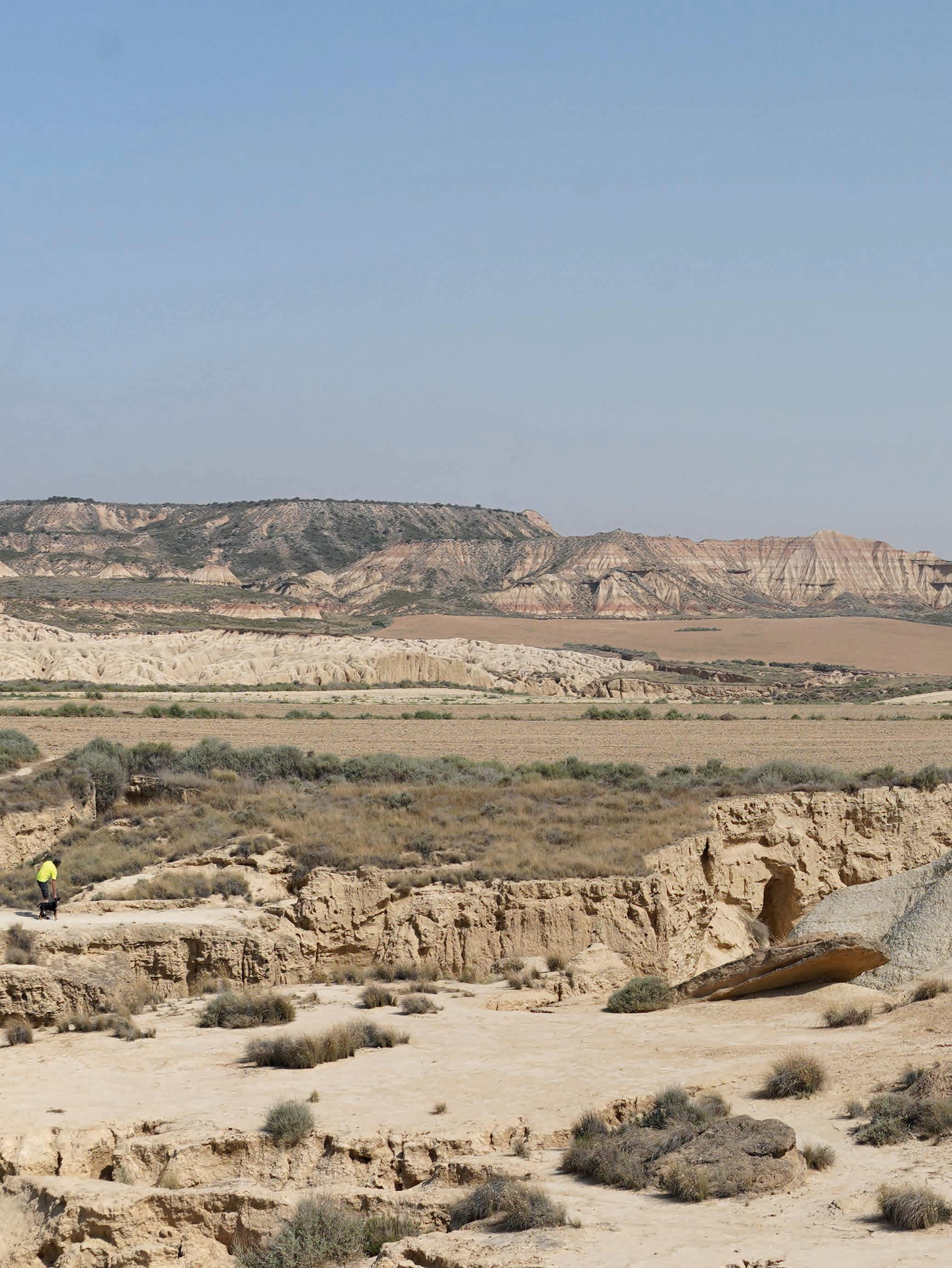
VOLUME 41 I ISSUE 5 I MAY 2023

cgg.com/earthdata SE E THINGS DI FF ERE NT LY ALL-ROUND BETTER SUBSURFACE IMAGING Scan the QR code to see for yourself.
An EAGE Publication
CHAIR EDITORIAL BOARD
Gwenola Michaud (Gwenola.Michaud@cognite.com)
EDITOR
Damian Arnold (arnolddamian@googlemail.com)
MEMBERS, EDITORIAL BOARD
• Lodve Berre, Norwegian University of Science and Technology (lodve.berre@ntnu.no)
Philippe Caprioli, SLB (caprioli0@slb.com) Satinder Chopra, SamiGeo (satinder.chopra@samigeo.com)
• A nthony Day, PGS (anthony.day@pgs.com)
• Peter Dromgoole, Retired Geophysicist (peterdromgoole@gmail.com)
• Rutger Gras, Consultant (r.gras@gridadvice.nl)
• Stephen Hallinan, CGG Stephen.Hallinan@CGG.com
• Hamidreza Hamdi, University of Calgary (hhamdi@ucalgary.ca)
Clément Kostov, Freelance Geophysicist (cvkostov@icloud.com)
Peter Rowbotham, Apache (Peter.Rowbotham@apachecorp.com)
• Pamela Tempone, Eni (Pamela.Tempone@eni.com)
• A ngelika-Maria Wulff, Consultant (gp.awulff@gmail.com)
EAGE EDITOR EMERITUS
Andrew McBarnet (andrew@andrewmcbarnet.com)
PUBLICATIONS MANAGER
Martha Theodosiou (mtu@eage.org)
MEDIA PRODUCTION
Saskia Nota (firstbreakproduction@eage.org)
PRODUCTION ASSISTANT
Ivana Geurts (firstbreakproduction@eage.org)
ADVERTISING INQUIRIES corporaterelations@eage.org
EAGE EUROPE OFFICE
Kosterijland 48
3981 AJ Bunnik
The Netherlands
• +31 88 995 5055
• eage@eage.org www.eage.org
EAGE MIDDLE EAST OFFICE
EAGE Middle East FZ-LLC
Dubai Knowledge Village
Block 13 Office F-25
PO Box 501711
Dubai, United Arab Emirates
• +971 4 369 3897 middle_east@eage.org
• www.eage.org
EAGE ASIA PACIFIC OFFICE
UOA Centre Office Suite 19-15-3A
No. 19, Jalan Pinang
50450 Kuala Lumpur Malaysia
• +60 3 272 201 40
• asiapacific@eage.org
• www.eage.org
EAGE AMERICAS SAS
Edificio Centro Ejecutivo Santa Barbara Av. Cra. 19 #118-95 - Office: 501
• +57 310 8610709
• americas@eage.org
• www.eage.org
EAGE MEMBERS CHANGE OF ADDRESS NOTIFICATION
Send to: EAGE Membership Dept at EAGE Office (address above)
FIRST BREAK ON THE WEB www.firstbreak.org
ISSN 0263-5046 (print) / ISSN 1365-2397 (online)
Burying carbon on the Gulf Coast
Sp ecial Topic: Global Exploration Hotspots
51 Imaging the Lower Cretaceous complex fault systems using common reflection angle migration, Abu Gharadiq Basin, Western Desert, Egypt Ahmed El-Bassiony, Magdy Fahmy, Ahmed, Lotfy and Bamba Esinov
57 Unear thing hidden exploration potential: The Vade Sand of the North Sea
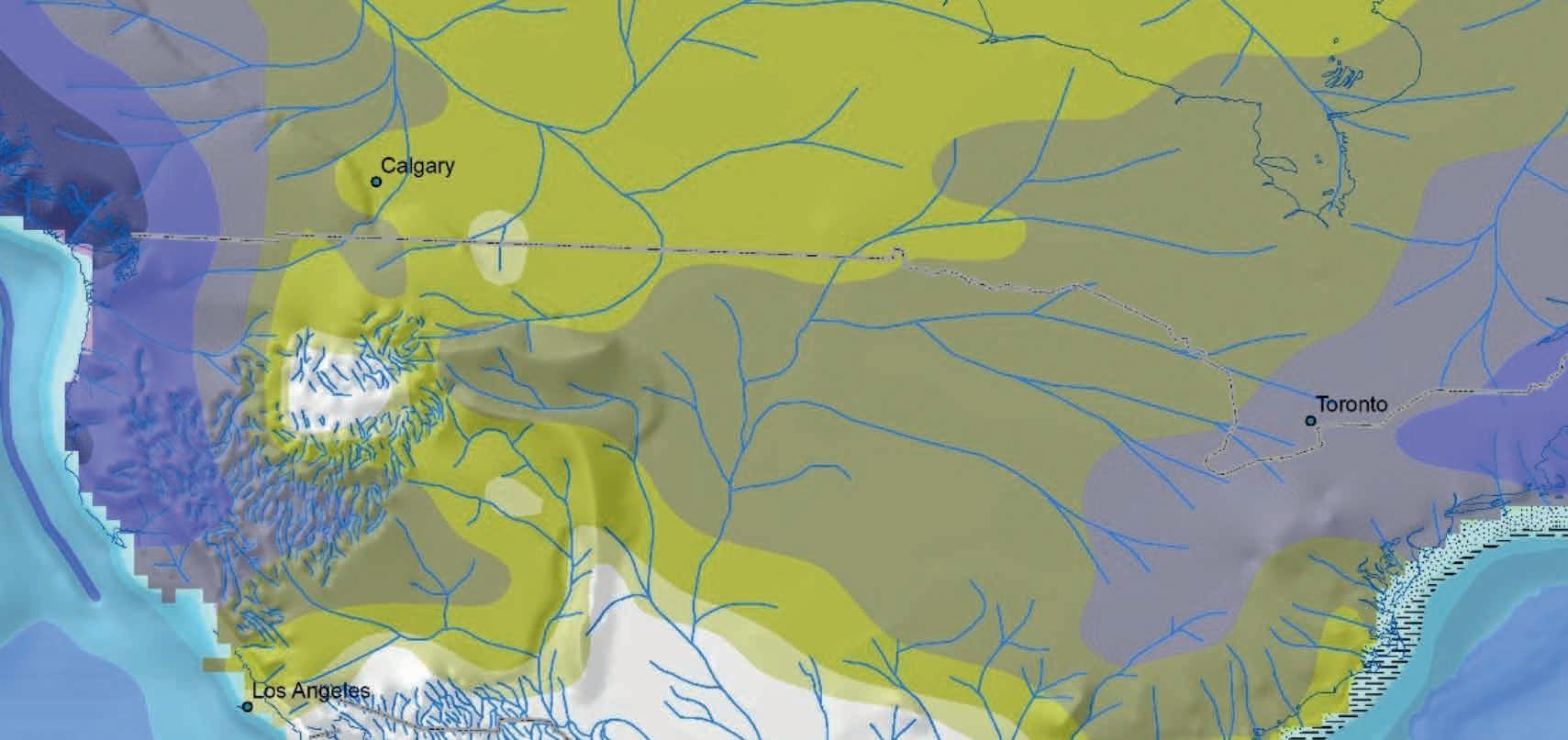
Carl Fredrik Gyllenhammar, Daniel Baltar, Peter Keller, and Jon Sandvik
63 How technological advances in seismic acquisition, processing and imaging can bring new insights to near-field exploration
Federico Buriola, Jaswinder Mann-Kalil, Thomas Latter, Idar Kjørlaug and Anna Rumyantseva
71 Bur ying carbon on the Gulf Coast William A Heins
78 Frontier basins of Latin America: realising deep-water potential Kyle Reuber
84 The need to make funding more available to explore global ‘hotspots’ as key part of a realistic energy transition Mike Lakin
93 Rethinking seismic sensors to reform onshore exploration in the Middle East and Asia Chris Einchcomb
WhatsUp!
96 Winds of Change – Making the transition from the hydrocarbon to the offshore wind industry
Monica Calvert
98 Calendar
cover: Lower Cretaceous complex fault systems at Abu Gharadiq Basin, Western Desert, Egypt. This month we present better depth imaging of the Lower Cretaceous complex fault system at the AbuSennan field in the Western Desert.
FIRST BREAK I VOLUME 41 I MAY 2023 1 Editorial
3 EAGE News 15 Personal Record Interview 16 Monthly Update 18 Crosstalk 21 Industr y News
Articles
Contents
Technical
31 High-resolution digital outcrop models of fossil-rifted margins: 3D imaging of extensional detachment systems Peter Betlem, Geoffroy Mohn, Julie Tugend and Gianreto Manatschal 41 New template for fluid detection driven by Extended Elastic Impedance Javad Sharifi
Feature:
71
FIRST BREAK ®
European Association of Geoscientists & Engineers
Board 2022-2023
Near Surface Geoscience Circle
Esther Bloem Chair
Andreas Aspmo Pfaffhuber Vice-Chair

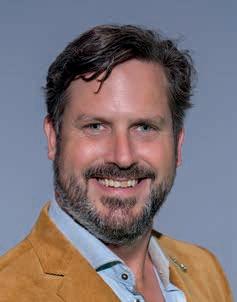
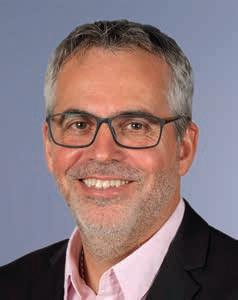
Micki Allen Contact Officer EEGS/North America
Adam Booth Committee Member
Hongzhu Cai Liaison China
Deyan Draganov Technical Programme Officer
Wolfram Gödde Liaison First Break
Hamdan Ali Hamdan Liaison Middle East
Vladimir Ignatev Liaison Russia / CIS
Musa Manzi Liaison Africa
Myrto Papadopoulou Young Professional Liaison
Catherine Truffert Industry Liaison


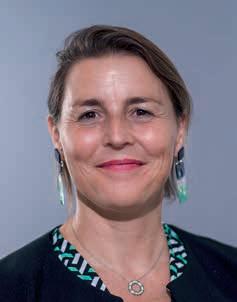
Panagiotis Tsourlos Editor in Chief Near Surface Geophysics
Florina Tuluca Committee member
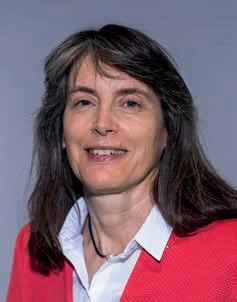
Oil & Gas Geoscience Circle
Lucy Slater Chair
Yohaney Gomez Galarza Vice-Chair
Michael Peter Suess Immediate Past Chair; TPC
Erica Angerer Member
Wiebke Athmer Member
Juliane Heiland TPC
Tijmen Jan Moser Editor-in-Chief Geophysical Prospecting

Adeline Parent WGE SIC Liaison
Matteo Ravasi YP Liaison
Jonathan Redfern Editor-in-Chief Petroleum Geoscience
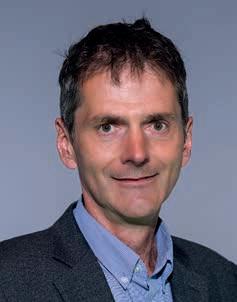
Giovanni Sosio DET SIC Liaison
Aart-Jan van Wijngaarden Technical Programme Officer
SUBSCRIPTIONS
First Break is published monthly. It is free to EAGE members. The membership fee of EAGE is € 80.00 a year including First Break, EarthDoc (EAGE’s geoscience database), Learning Geoscience (EAGE’s Education website) and online access to a scientific journal.
Companies can subscribe to First Break via an institutional subscription. Every subscription includes a monthly hard copy and online access to the full First Break archive for the requested number of online users.
Orders for current subscriptions and back issues should be sent to EAGE Publications BV, Journal Subscriptions, PO Box 59, 3990 DB, Houten, The Netherlands. Tel: +31 (0)88 9955055, E-mail: subscriptions@eage.org, www.firstbreak.org.
First Break is published by EAGE Publications BV, The Netherlands. However, responsibility for the opinions given and the statements made rests with the authors.
COPYRIGHT & PHOTOCOPYING © 2023 EAGE
All rights reserved. First Break or any part thereof may not be reproduced, stored in a retrieval system, or transcribed in any form or by any means, electronically or mechanically, including photocopying and recording, without the prior written permission of the publisher.
PAPER
The publisher’s policy is to use acid-free permanent paper (TCF), to the draft standard ISO/DIS/9706, made from sustainable forests using chlorine-free pulp (Nordic-Swan standard).
2 FIRST BREAK I VOLUME 41 I MAY 2023
Caroline Le Turdu Membership and Cooperation Officer
Peter Rowbotham Publications Officer
Pascal Breton Secretary-Treasurer
Aart-Jan van Wijngaarden Technical Programme Officer
Esther Bloem Chair Near Surface Geoscience Circle
Lucy Slater Chair Oil & Gas Geoscience Circle
Edward Wiarda Vice-President
Jean-Marc Rodriguez President
Maren Kleemeyer Education Officer
Closing in on the big event: make sure you’re there!
It’s only a month to go before we will soon be welcoming our global community of geoscientists and engineers for a week of transformational learning and networking opportunities during the 84th EAGE Annual Conference and Exhibition at Messe Wien Exhibition & Congress Centre between 5-8 June 2023.
The theme of our Annual this year is ‘Securing a sustainable future together’. The focus will be on the key issues of energy security and independence, a sustainable energy transition and how we all need to adapt our traditional ways of working and cooperation to address this uncertain future.
Ready to join another fantastic edition of our truly multi-disciplinary event in Vienna? Here are some highlights you can expect.
Opening Session
The EAGE Annual 2023 kicks off with the official Opening Session which features key discussions with leading energy figures and awards recognising excellence in geoscience and engineering.
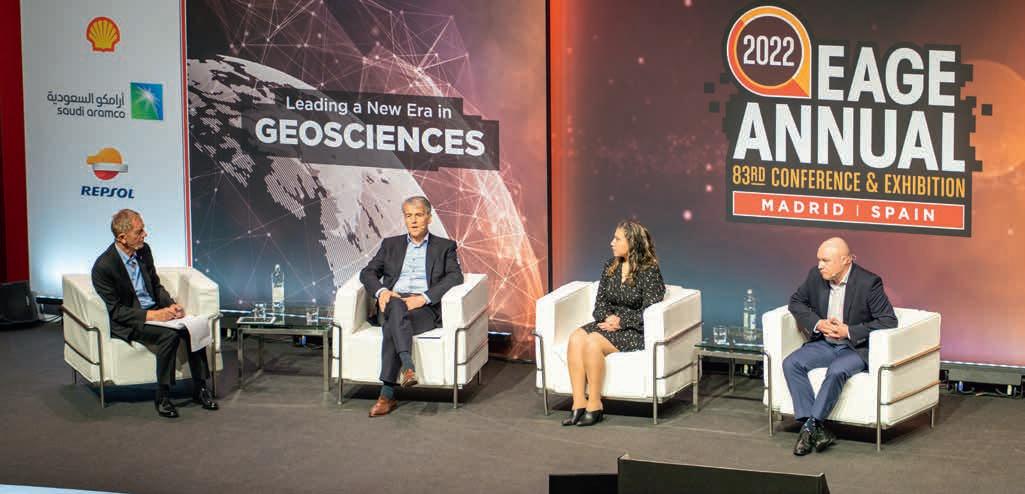
Technical Programme
The Technical Programme of the EAGE Annual 2023 brings together the selection of the high-quality papers submitted during the two Call for Abstracts periods. The disciplines represented in this year’s Technical Programme include Geophysics, Geology, Reservoir Engineering, Integrat-
ed Subsurface, Mining and Infrastructure, Data and Computer Science, and Energy Transition. This year the poster sessions will be conducted in a printed poster format intended to create more interaction and informal exchange of ideas and discussions between participants.
The SPE EuropEC programme will again be showcased during the EAGE Annual 2023, offering even more diversity of geoscientific and reservoir engineering contributions.

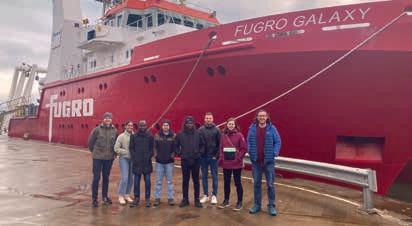
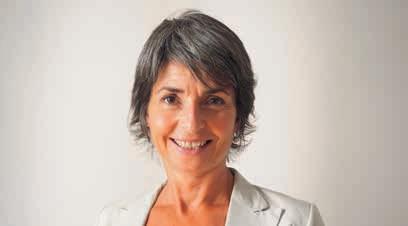
Strategic Programme
Building on the popular Forum Sessions at recent Annual meetings, this year we introduce the Strategic Programme. Recognising the challenges and turmoil we face in the world today, the Strategic Programme will showcase how the latest geophysical, geological, and engineering research, ideas and case studies have a vital contribution to make in the quest for solutions. The topics for discussions include exploration strategy,
FIRST BREAK I VOLUME 41 I MAY 2023 3 EAGE
08
election candidates
10
14 HIGHLIGHTS
Student vessel visit a hit
Brazil venue for deepwater discussion
Hear from key industry leaders in the new Strategic Programme.
its implications and the path ahead; potential technological and innovation pathways for the energy system of the future; challenges and opportunities to deliver a sustainable energy transition; the workforce and skills for the future; etc. You can look forward to joining our panellists from among others: OMV Petrom, OMV E&P, TotalEnergies, SLB, Wintershall Dea, CGG, TGS, Chevron, S&P Global Commodity Insights, Equinor, ExxonMobil, Petronas, and Kuwait Oil Company.
The workshop programme focuses on interactivity, with a broad range of features, such as discussions, exercises, activities and practical applications. This year 15 workshops will cover the spectrum of EAGE’s multi-disciplinary communities complementing the Technical Programme. Topics include geology, geochemistry, geostatistics, geophysics and energy transition (geothermal, hydrogen, CCS).
Four interesting field trips are on offer, providing you a chance to explore
Oil & Gas Professionals’. All these courses allow you to obtain credits for your participation.
This year’s EAGE Annual Hackathon focuses on the theme Natural Language Processing (NLP). Whether you are a geoscience professional looking to learn about NLP or an NLP expert looking to apply your skills to a new field, this is an opportunity to learn from experts, network with peers, and showcase your skills.
Community and student activities
During the EAGE Annual 2023 in Vienna, you can once again catch up with our wider community, including Local Chapters, Student Chapters, Special Interest Groups and Technical Communities, and join them for informative discussions at the Community Hub. We will also be organising some activities to support those interested in career development.
Networking experience
Exhibition
Visiting the Exhibition is a must to update your professional knowledge as well as to meet the people behind the many geoscience and related products, services and innovations available today. Our exhibitors include energy operators, service providers, start-ups, universities and associations, all looking forward to meeting you.
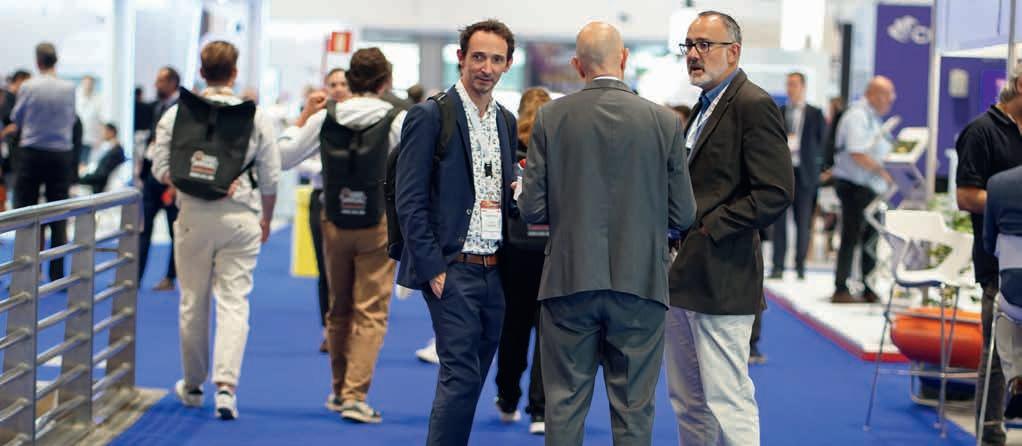
We are delighted to include once again the special interest areas’ theatre talks that seek to promote the new and latest energy resources development model we are moving towards. The Digital Transformation theatre programme provides a look to the future with new ideas and new ways of working smarter, faster and more efficiently. Meanwhile, the Energy Transition theatre programme offers an insight into how companies and research organisations are mapping the pathway to net-zero emissions.
Workshops, Field Trips, Short Courses and Hackathon

As usual, a selection of Workshops, Field Trips, Short Courses and Hackathon are on offer on Sunday and Monday before and Friday after the main Conference and Exhibition.
and gain better insight into the geology of Austria. You can choose from a tour of the OMV Innovation and Technology Centre, a tour to historical buildings in Vienna, a site visit to the Neogene of the Vienna Basin and a meeting on geothermal energy utilisation in the Styrian Basin.
You also have the opportunity to update your knowledge on the latest energy transition trends through three short courses ‘An Introduction to Offshore Wind’, ‘Basics of Carbon Capture and Storage’ and ‘Energy Transition for
No Annual would be complete without multiple networking opportunities. We have planned a social programme, including the Icebreaker Reception and the Conference Evening at Kursalon Wien, alongside the customary afternoon drinks in the Exhibition area and special networking lunches.
We also welcome your partner and family members to join us in Vienna. All registered accompanying persons have access to the Opening Session, Exhibition (including coffee points and afternoon drinks), Icebreaker Reception, Conference Evening and accompanying persons’ tour.
Don’t leave it too late to register!
Make sure you head over to www.eageannual.org to find out more details and, most important, register in time. You can sign up for a full week or per day, for the full Conference or Exhibition only. If you wish to maximise your time away from the office and take part in multiple activities during the EAGE Annual, consider opting in for the All Access package. An All Access pass grants you access to the workshops, field trips, short courses and hackathon, in addition to the Conference, Exhibition, Icebreaker Reception and Conference Evening. Kindly note that the SPE training course is not included in the All Access package and must be registered separately.
Remember: you can save with the discounted fees if you reserve your attendance before 15 May 2023.
4 FIRST BREAK I VOLUME 41 I MAY 2023 EAGE NEWS
The Annual Exhibition, a place where you can see the familiar faces of the industry, but also meet the most forward thinking and inspirational people in the field.
IMAGING THE FULL WAVEFIELD Technology that delivers
Rapid turnaround
Superior imaging using field data
Simultaneous model building & imaging
Significantly better illumination by using more signal (multiples, ghosts & prismatic waves)
Reflectivity, velocity, anisotropy, AVA, source signatures, attenuation
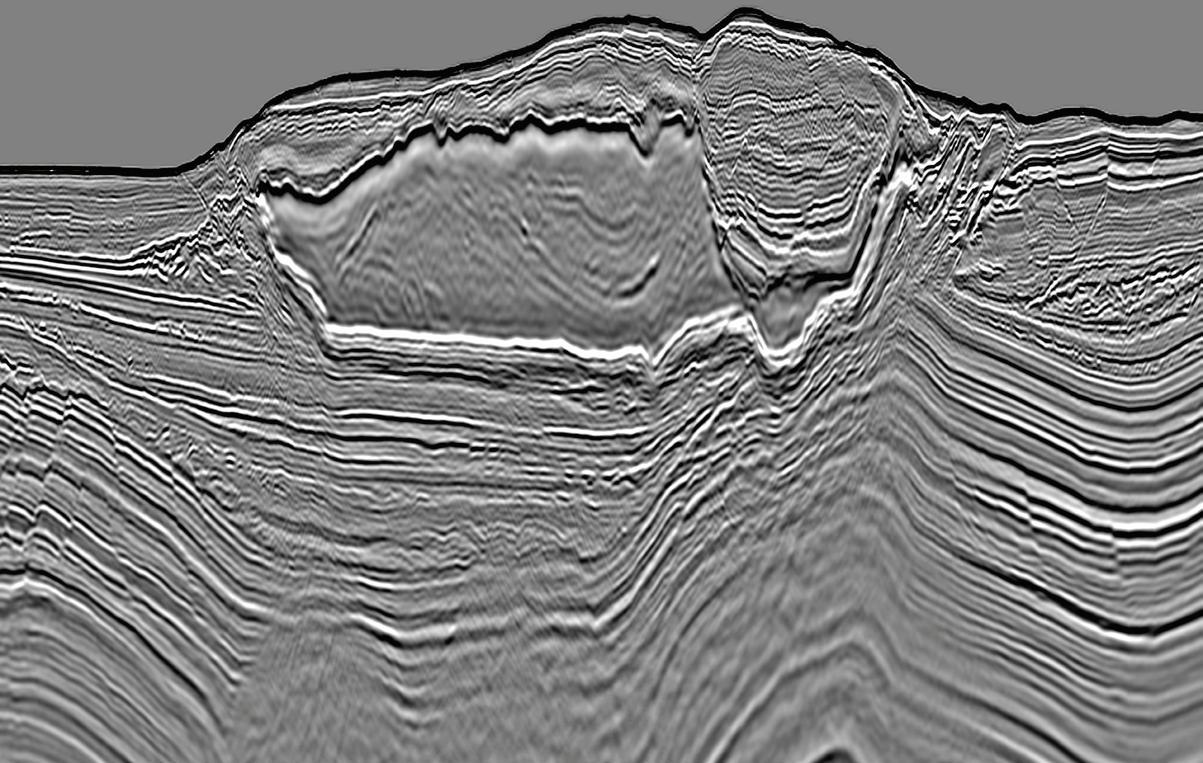
Obtain unrivalled results faster, even in complex salt environments, with DUG’s Multi-parameter FWI Imaging technology. Simultaneous model-building and high-frequency, least-squares imaging deliver accurate, high-resolution Earth models using field-data input—without the many time-consuming, subjective, serial steps of a conventional processing and imaging workflow!
Drop by Booth 2300 at the 2023 EAGE Annual Conference & Exhibition to learn more!
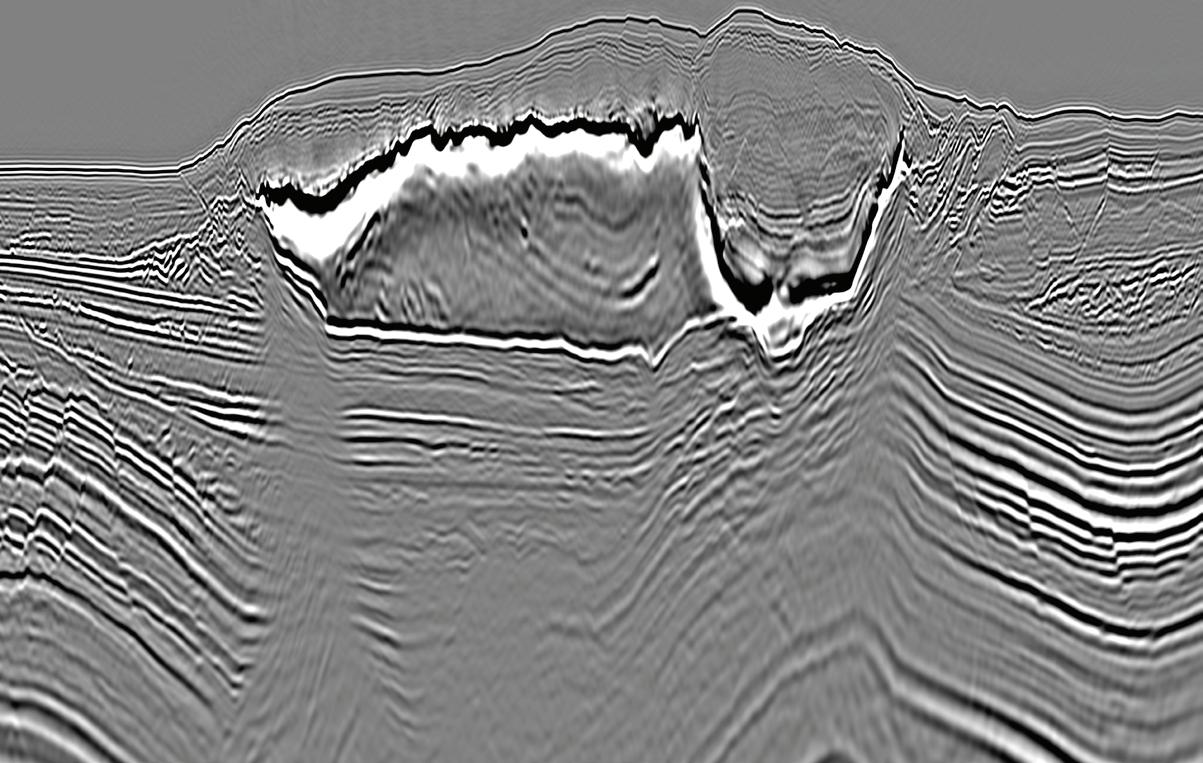
•ISO 27001• OC M PASSASSURANCESERV SEC •ISO 9001• OC M PASSASSURANCESERV SEC dug.com/fwi
A comparison between imaging results in a complex salt environment, offshore Gulf of Mexico. TOP: Conventional reverse time migration (RTM), after pre-processing and regularisation. BOTTOM: DUG MP-FWI Imaging result using field-data input. Superior resolution. Superior imaging. RTM
DUG MP-FWI Imaging
Powerful physics
EAGE Communities host career development sessions at the EAGE Annual
A feature of our Annual Meeting will be career development sessions prepared by EAGE Communities intended for those wanting to broaden their perspective on industry opportunities and strengthen their professional network.

The YP Special Session will be the traditional gathering of students and young
future together’. The focus will be on the importance of inclusive and diverse ‘together’ in tackling global issues such as energy transition, and will particularly reflect on the role of women in leading the transition.
A very accomplished leader in sustainability, Mikki Corcoran (vice-president,
In the Interactive Session ‘Skills for the Energy Transition”, the Education Committee and the DET Committee Members will present their analysis on mapped energy transition-related skills vis-a-vis the courses offered in EAGE, unveiling career development opportunities and alternatives to strengthen our education portfolio.
Additionally, companies in search of new talent with skills related to energy transition will present their needs/ requirements, aiming to encourage professionals attending the conference to explore possibilities in their organization.
people getting together to discuss professional and personal development. As the boundaries between subjects, technologies, industries and research topics become less obvious, the theme this year is the multi-discipline and diversity of career opportunities within and beyond geoscience. The speaker line-up features members of our Technical Communities — Chris Nind (Mineral Exploration Geophysics), Johan Robertsson (Seismic Acquisition), Olena Ivanik (Geohazards) and Carla Martin-Clave (Decarbonization and Energy Transition).
We are striving to paint a colourful picture of how geoscience, digital technology, engineering, and the growing demand for energy are intertwined so the audience will have a sense of not only what skills are useful in future careers, but also what the careers can look like with the skills on hand. The YP session will be followed by a young-professional networking event together with SPE. You can join the session on Tuesday 6 June from 16:00 to 18:30 CEST at the EAGE Community Hub/Theatre.
The topic for this year’s WGE Special Session reflects on the main theme of the EAGE Annual – ‘Securing a sustainable
sustainability, SLB), will be the session’s keynote speaker. Her presentation will cover driving equity in the workplace, supply chain and the communities that we live and work in, to enable a just transition.
With over 20 years in the energy industry, Corcoran is leading the future of sustainability at SLB. The presentation will be followed by an interactive session, where we will drill into some of the most common barriers that women face when entering the renewable energy sector and energy transition. The scope of the discussion is expected to include the tools and solutions to overcome such barriers on an individual level, at the level of one’s workspace, and finally at the level of the society.
You can participate in the WGE session on Wednesday 7 June from 16:00 to 18:00 CEST at the Brasserie Room.
There is more. The Decarbonization and Energy Transition (DET) Technical Community is joining with the Education Committee to lead a special occasion on Thursday 8 June (10:00-11:30 CEST) at the EAGE Community Hub/Theatre, intended to help members connect with professionals already involved in energy transition and facilitate the support for those wanting a change in their careers.
The concluding part of the session will focus on an interactive CV check and networking activity for students, young and mid-career professionals who are interested in an energy transition-related career and how they fit into potential roles in the field.
If your focus is on machine learning, artificial intelligence and advanced language models, the Committee of EAGE’s Seismic Interpretation Technical Community invites you to a lively and engaging debate on Thursday 8 June (12:00-13:30 CEST) at the EAGE Community Hub/Theatre, to discuss the role of machines in our industry and seismic interpretation, as well as what it means for our role as geoscientists moving forward.
Attendees to the Annual Conference will also have the chance to strengthen their CV in our traditional CV check and professional portrait photography sessions (6-8 June, EAGE Community Hub), and may also connect with representatives from companies or/and academia in the Networking Cafe scheduled for Wednesday 7 June, from 14:0015:00 CEST, at the EAGE Community Hub.
All these sessions are included in the conference Community Programme. Find out more details on www.eageannual.org.
6 FIRST BREAK I VOLUME 41 I MAY 2023 EAGE NEWS
EAGE’s career development sessions are part of the Annual’s Community Programme.
Energy transition opportunities will be a big feature at this year’s Annual
At this year’s Annual we are continuing our mission to offer a platform for EAGE members, both professionals and students, and companies wanting to engage in ongoing energy transition initiatives.

Not only will there be a Dedicated Session on Energy Transition but also several presentation sessions covering related topics in the Technical Programme, such as carbon capture and storage, geothermal energy and underground energy storage. In addition, members will have access to other activities like the Energy Transition Theatre, offering all-day discussions and talks, and the EAGE Community Hub.
The Decarbonisation and Energy Transition Community will be supporting and actively participating in the new activities to make it easier for members to interact and provide feedback. The main aim in implementing all these new dedicated spaces is to help members connect with professionals already involved in energy transition activities and facilitate help for those wanting a change in their careers.
The oil and gas industry comprises a large body of highly trained technical professionals able to deliver the necessary infrastructure and services linked to energy transition. These highly qualified geoscientists and engineers bring decades of experience in exploration and production of the subsurface and in the development of sophisticated models
using a vast amount of geophysical and geological data.
As an example, carbon capture, utilisation, and underground storage (CCUS) offers solutions for reducing carbon emissions released into the atmosphere while increasing energy mix production capacity from zero-carbon energy sources. CCUS has been extensively tested in projects such as the Sleipner project with injections in deep saline aquifers.
Other renewable energy sectors, such as offshore wind or geothermal energy, have already demonstrated how valuable transferable skills from the oil and gas industry are to the growth of these sectors. Seismic acquisition, analysis and interpretation, structural geology, rock mechanics and geochemistry are just some of the core skills required to derive geological characterisation of environments suitable for both wind farm installation and geothermal resource prospection. Drilling and borehole log interpretation are also skills in demand to fill job positions related to CCUS, underground energy storage and geothermal energy. Other high technological skills, such as big data analysis and programming, will be also necessary to develop digitalisation solutions for these new industries and facilitate the integration of different sets of data within models, thereby increasing the optimisation of the data. Both high and low skills
Online Education Calendar
at management and administrative level will also be a requirement.
That’s why at this year’s Annual we are presenting more sessions to discuss the necessary skills for the energy transition era at the EAGE Community Hub. EAGE’s Decarbonisation and Energy Transition Community is looking forward to meeting you, the members, and hopefully providing knowledge and advice helpful for your professional development.
eBooks on EarthDoc
Did you know that EAGE’s book collection covers many different fields of study within earth sciences, including tectonics, economic geology, petrology, stratigraphy, marine studies, geophysics and geostatistics? The collection also includes many of the training manuals for educational events organized by EAGE.
EAGE book titles are available in the Epub format on EarthDoc where members can benefit from a 15% discount on the list prices.
FIRST BREAK I VOLUME 41 I MAY 2023 7 EAGE NEWS
FOR THE FULL CALENDAR, MORE INFORMATION AND REGISTRATION PLEASE VISIT WWW.EAGE.ORG AND WWW.LEARNINGGEOSCIENCE.ORG. 4 MAY15 JUN NAVIGATING CAREER CHALLENGES AND OPPORTUNITIES OF THE ENERGY TRANSITION BY E. BLOEM, L. LEVATO, & G. MICHAUD EXTENSIVE ONLINE COURSE 24 HRS. (INCL. 6 WEBINARS OF 2.5 HRS EACH) 8 MAY8 JUN INTRODUCTION TO MACHINE LEARNING FOR GEOPHYSICAL APPLICATIONS BY JAAP MONDT EXTENSIVE ONLINE COURSE 14 HRS (INCL. 5 WEBINARS OF 1-3 HRS EACH) 8-9 MAY AN INTRODUCTION TO OFFSHORE WIND BY JEROEN GODTSCHALK IOSC 4 HRS/DAY, 5 MODULES 15-16 MAY SEISMIC RESERVOIR CHARACTERIZATION: AN EARTH MODELING PERSPECTIVE BY PHILIPPE DOYEN IOSC 4 HRS/DAY, 7 MODULES 22-25 MAY PALYNOLOGY FOR GEOLOGISTS BY MIKE STEPHENSON IOSC 4 HRS/DAY, 6 MODULES
EAGE
Candidates for 2023 EAGE elections
Ahead of the Annual Ballot for EAGE positions, we publish here statements for the candidates for various available positions in the Association. Voting takes place online between 1 May and 1 June with results announced at the Annual General Members Meeting on Wednesday 7 June in Vienna.
Laura Valentina Socco –Vice-President
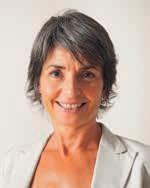
It is a great honour and responsibility to have been nominated for vice-president of EAGE. We are living in challenging and exciting times. Environmental emergency and geopolitical instabilities are driving the acceleration of energy transition, and this poses to our community new questions, new challenges, new opportunities. In spite of the uncertainties, all the analysts see an increasing market for geoscience and engineering services and industry in the coming years. This gives EAGE, a diverse and global society that merges academia and research, industry and services, professionals, the opportunity and the mission to be a place for envisaging, sharing and promoting innovation and game-changing solutions aimed at improving sustainability while granting security. The unique knowledge and diversity of EAGE members represents outstanding value not only for industry and academia, but also for the potential role of providing a knowledge-based and unbiased platform for institutions and policy makers.
Beside applications related to hydrocarbon exploration and production that will need ongoing evolution towards sustainable processes and will continue to lead technological investments in the coming years, new opportunities will be generated in the energy transition industry, in the mineral resources field, in environmental applications including climate engineering, and in engineering activities. I cannot imagine a better place than EAGE to stimulate these new opportunities.
Digital technologies are taking over many activities usually carried out by humans and this creates the need for new competencies and education, and requires the development and spreading of new
technologies modifying the way we use data. Open science and open data on one side and education on the other are key points in the digital transition.
For the nearest future, my commitment will focus on the following objectives: Increasing the space and visibility of the energy transition community with special focus on initiatives on decarbonization; Promoting the cross fertilisation among different fields within the EAGE and outside the actual EAGE arena to increase opportunities for research and industry; Reinforcing an inclusive EAGE promoting actions and policies aimed at removing biases against diversity and facilitating equal opportunities; Widening the education opportunities for young professionals and lifelong learning initiatives; Strengthening and supporting our community of students; and Stimulating the debate on creating platforms for open data and open science sharing for mutual benefit of industry, academia and institutions.
During my academic career and participation in EAGE life with various roles in the past two decades, I have been so lucky to work with equal commitment in many different fields of application of geophysical exploration ranging from very shallow engineering problems, to near surface aspects of hydrocarbon exploration, from environmental and geohazard applications to mineral resources exploration. This has given me a clear view of the fact that we are a unique and diverse community, with a shared language and fundamental knowledge, but with a precious variety of competences, goals, and sensibilities. This diversity is our richness and the efforts that have been done in the past to increase age, gender, disciplinary, and geographical diversity of our society should be continued. And this diversity is what enables us to offer effective, local and customised solutions to global problems.
Peter Rowbotham –Publications Officer

It has been an honour to serve as EAGE Publications Officer for two years, and I am seeking members’ support to continue for another two. I have derived huge benefits from my membership of EAEG/EAGE since 1991, especially from being able to present and publish my work in my early career. As well as our larger conferences, it is encouraging to see our communities and local chapters offering alternative ways for presenters to highlight their work, either in person or remotely.
Since 2022, our publications portfolio has expanded to include the new Geoenergy journal to cater for Sustainable Energy topics. Geoenergy is a sister to Petroleum Geoscience, and likewise is co-owned with the Geological Society of London. I am pleased to report that all our journals are maintaining the high standards expected by our members, and review times are consistently short, giving authors confidence that their results will be published in a timely manner. This in no small part is due to the efforts of our volunteer editors and reviewers and on behalf of all members, I acknowledge the time invested and thank them for these efforts. As with all aspects of EAGE activities, we always need fresh energy so if you are able to offer your services, please get in touch.
For the next period my focus areas will be further integration of our education and publication programmes, and a continual assessment of how our publications are meeting the needs of the membership.
As a Board, key themes will be transitioning to the new Oil and Gas Geoscience, Near Surface Geoscience and Sustainable Energy Circles whilst continuing to ensure cross-discipline and member-focus.
8 FIRST BREAK I VOLUME 41 I MAY 2023 EAGE NEWS
Carla Martín Clavé –Chair, Sustainable Energy Circle

Since I started studying my degree in geology, I have always been interested in working in projects related to the energy sector. As a geologist I think geoscience has an important role to play in delivering Net Zero. I also believe the oil and gas industry has the most important pool of professionals to make energy transition possible. Energy transition is being shaped not only by the climate crisis emergency but also by political trends. We are currently going through a very convulsive period facing crisis after crisis.
While global economies are still recovering from the Covid-19 pandemic hit, European political challenges keep bringing significant disruptions in trade, food and fuel prices resulting in inflation at a record high not observed in the last 40 years. And while governments work to set up their strategies for Net Zero, global temperatures keep increasing every year. Internationally, recognised associations such as the EAGE are key to providing a safe platform for professionals to share their work and help the public and governments to access crucial data and education material to keep improving and sharing our knowledge.
My aim is to keep working with the different EAGE committees, groups and members to identify transferable skills and opportunities to boost energy transition within our community. After two years actively supporting the EAGE Decarbonisation and Energy Transition Community,
I hope to keep bringing in my passionate character to get more involved with the EAGE Board and shape the future of EAGE for our members at all career stages.
Giovanni Sosio –Vice Chair, Sustainable Energy Circle
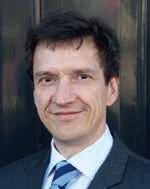
As an engineer and geoscientist working in the energy industry for more than 15 years, I have witnessed the early decarbonisation efforts in the industry and I have been lucky to be involved first-hand in several initiatives. The most effective accelerator, in all cases, has been the possibility to share the knowledge and mutualise the best practices, and I have appreciated the support of the industry associations in this effort.
My motivation to serve as a vice-chair of the Sustainable Energy Circle is driven by:
1) The desire to build on the enthusiasm of the Decarbonisation and Energy Transition Community. I will help continue the initiatives that it has started, most notably to support the career transition efforts by the members of the Association; 2) The specific role of the vice-chair is ensuring the liaison between the three Circles, where I would leverage my background and my daily involvement in shallow and deep geosciences. My aim will be to maintain the porosity between the Circles and the representation of the near surface and oil and gas geoscience communities in building and sharing solutions for the Energy Transition; and 3) The possibility to help shaping a ‘spiritual home’ for the Asso-
ciation’s efforts to establish a sustainable geoscience community. I would advocate for clearer messaging, the availability of online resources for the members, a thriving forum in the GET conferences and an insightful outlet with the Geoenergy journal.
Johannes Wendebourg –Vice Chair, Oil and Gas Geoscience Circle

As EAGE vice-chair of the Oil and Gas Geoscience Circle (OGGC) I will continue to make that the geoscience disciplines of geophysics, geology and reservoir engineering in the oil and gas industry will continue to be at the heart of the EAGE.
The energy transition poses new and unprecedented challenges to the industry and the geosciences in general. EAGE is well positioned to respond to these challenges through its highly diverse and international membership and its innovation and technological progress which is the hallmark of the organisation. A particular emphasis will be on the integration of our young geoscience professionals in the industry. Communication and cooperation between disciplines and with industrial and societal stakeholders will be more important than ever. I will promote and foster this with our academic partners and industry sponsors, and through the various enablers within EAGE such as publications, conferences and other events. This includes joint collaboration, synergies, knowledge sharing and efficient exchanges between Circles.
ADDITIONS THIS MONTH
On 5-8 June 2023, EAGE will be hosting its 84th Annual Conference and Exhibition. Conference abstracts will be available on EarthDoc two weeks before and throughout the conference. Multiple disciplines will be represented, including geophysics, geology, reservoir engineering, integrated subsurface, energy transition, mining and infrastructure and data & computer science.
New issues of Geophysical Prospecting and Petroleum Geoscience will be published in May. And lastly, don’t forget to check this month’s open access content.
FIRST BREAK I VOLUME 41 I MAY 2023 9 EAGE NEWS
Ship visit a hit for Aberdeen students
With the opportunity of Fugro Galaxy in harbour on 4 March 2023, our LC Aberdeen and Fugro offered local geophysics students from the University of Aberdeen a chance to visit the vessel. Having just completed their MSc training in seismic acquisition and processing, students were given a guided tour of the vessel. Party Chief Wojciech Barej highlighted acquisition equipment, position monitoring, and onboard quality control (QC) and processing steps. Students asked on-board Fugro staff about all aspects of marine surveying and came away with direct understanding of the variety of key roles on a survey vessel.
Hydroscience SeaMUX digital system, with a seismic source of 160 cu in gun array with up to 1200m HTI solid digital streamer and a HiPAP 500 USBL system are permanently mobilised. The vessel is also capable of supporting larger seismic sources and longer streamers if required.
Following a hearty lunch on board the vessel, the students discussed seismic data QC and processing with the Fugro crew and altogether discovered a real sense of the range of skills required to work offshore. MSc student Abdullahi Muhammad described the experience: ‘I really enjoyed the visit
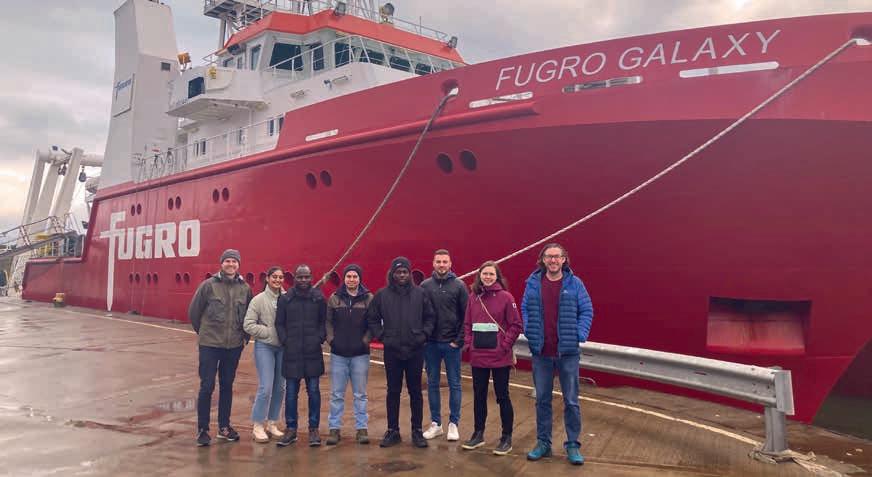
neers, surveyors, and other crew members; ii) effective communication for informing the different professionals and client about the procedures, reasons for changing the plan, unusual activities, results, etc.; and iii) a sound knowledge of the profession. The visit to the vessel has made me more interested in working offshore, and it has made me feel as if I have already worked with them on one of their projects. It is indeed one of the most memorable days of my life. I would like to thank my lecturers, the EAGE and all staff at Fugro for organising the visit.’
The MSc in Geophysics at the University of Aberdeen will celebrate its 10th year in 2024 and educates students with backgrounds in geology, geosciences, maths or physics in the breadth and depth of geophysics and its applications to real-world problems. Topics such as seismic acquisition and processing, environmental geophysics, GIS, and machine learning geophysics open careers in the broad energy transition sector including marine geoscience, but the MSc is a springboard into any geophysics industry or research profession.
Fugro Galaxy is a geophysical survey vessel that has mobilised geophysical and hydrographic surveys worldwide since 2011. A 65 m vessel that is designed to be acoustically quiet during survey activities, Fugro Galaxy is utilised for side surveys, pipelines routes and windfarm projects. The suite of survey equipment includes hull mounted single- and multi-beam echo sounders, with chirp and parametric sub bottom profilers. Edgetech dual frequency digital sidescan sonar, towed sub-bottom profilers, AUV, geotechnical and ROVSV are also available. A
to the seismic vessel because it gave me a wonderful opportunity to see the kinds of equipment used and different parts of the vessel. I now know more about Fugro’s operations in the marine environment, including the type and duration of their projects, and how they conduct them.
‘Furthermore, I learned a lot from examples of personal experiences and how life is on a seismic vessel. I have seen that a person working in a seismic vessel needs to have the following skills: i) teamwork for collaborating with geologists, geophysicists, engi-
Dr David Cornwell, senior lecturer in geophysics, said: ‘This was a fantastic opportunity from Fugro, facilitated by the EAGE Aberdeen LC, that really makes a difference and brings to life the topics we teach in class. I now have much better first-hand examples to add to my teaching for next year and, given our location, we are excited to engage with more opportunities to visit seismic and other vessels in Aberdeen harbour in the future. Placing students in working environments as part of their training in technical subjects such as geophysics is as essential as classroom, fieldwork and laboratory sessions, and getting a feel for a job can be the spark that ignites a successful career.’

10 FIRST BREAK I VOLUME 41 I MAY 2023 EAGE NEWS
MSc Geophysics students and staff with Fugro Galaxy (l-r): Ciaran Macdonald, Samar Al-Barwani, Abdullahi Muhammad, Gokhan Karakulak, Gesikeme Seibokuro, Serdar Cansu, Dr Katrin Löer, and Dr David Cornwell.
LC Houston debates future of energy

machine learning applications used in subsurface and wells domain. Amir Kianinejad (QRI), Judith Ponniah (AspenTech) and Chris Hanton (Ikon Science) talked about streamlining workflows, productisation and acceleration of project execution. Sougata Halder (TGS) illustrated the development of digitalisation pathways for energy decarbonisation, whilst Adrien Caudron (AspenTech SSE) explained how to improve subsurface knowledge to ease the path to energy transition.
After a long time of not coming together in-person LC Houston organised a full-day technical meeting in February crossing the borders between energy transition and digitalisation.
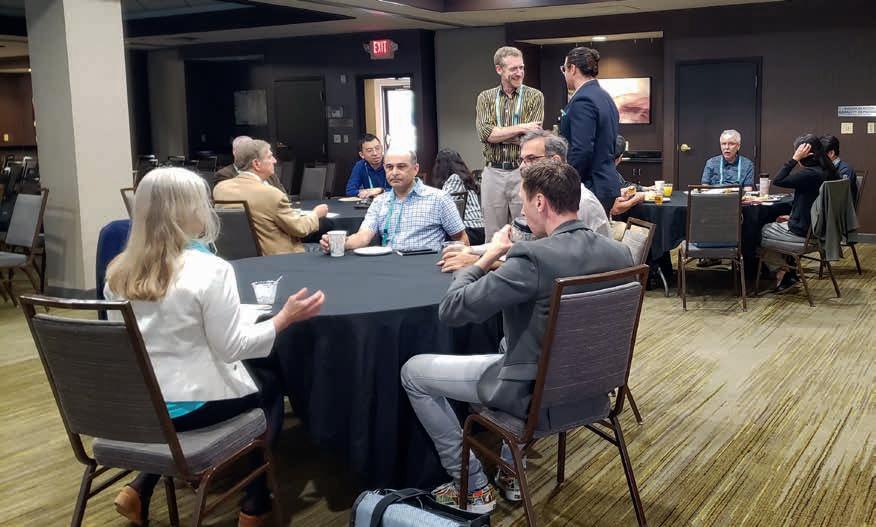
The format of nine 40-minute presentations on ‘Changing the Future of Energy by Utilizing Artificial Intelligence/Machine Learning and Big Data’ proved a success. The red thread of the day was how to best introduce the latest AI/ML and big data technologies on the journey to net-zero emissions by 2050. The speakers, industry experts from operators and solution/service providers, not only showcased their new technologies, but also focused on the implications of digitalisation for the industry along the path of the energy transition.
Allan Willis (LC president) opened the meeting before a keynote by Linh Nguyen (Deloitte Consulting), who
Student

specialises in helping energy clients leverage cloud technology to transform their operations for fulfilling their sustainability goals. The programme then featured presentations on CCUS, wind and hydrogen projects. Julien Chenin (Bluware) presented a case study from the North Sea for monitoring CO2 injection, whilst Haibin Di (SLB) shared another example using the Groningen Gas Field on subsurface modelling. Jay Chen (Shell) highlighted some of the
All in all, the event ended with many positive notes and compliments from the attendees. The LC would like to thank our sponsors for the event: Ikon Science (Gold), Deloitte (Silver), AspenTech (Bronze) as well as EAGE.
The Chapter would also like to acknowledge the organising committee for its hard work in preparing this fullday event: Kalyan Saikia (Deloitte), Evelyn Codes (EAGE LC Houston), Babita Sinha (EAGE LC Houston), Ayodeji Babalola (Hewlett Packard Enterprise), Diana Franco-Arias (PetroStrat), Mariela Araujo (Shell), Frank Gonzalez (TecShares), and Allan Willis (TGS).

FIRST BREAK I VOLUME 41 I MAY 2023 11 EAGE NEWS 1 MAY EAGE ONLINE GEOQUIZ - WINNERS ANNOUNCEMENT ONLINE 25 MAY EAGE STUDENT WEBINAR ONLINE 5-8 JUN 84TH EAGE ANNUAL CONFERENCE & EXHIBITION (STUDENT ACTIVITIES) VIENNA, AUSTRIA EAGE
FOR MORE INFORMATION AND REGISTRATION PLEASE CHECK THE STUDENT SECTION AT WWW.EAGE.ORG
Calendar
Meeting up in Houston.
Chris Hanton at the podium.
LC Paris reflects on diversity and inclusion in business
responsible parties. He also admitted that it is very important to offer training and education programmes to help employees develop cultural competency, recognise unconscious bias and understand the value of diversity.
Sarmiento said it is crucial to foster an inclusive culture, e.g., implement policies and practices that support inclusion, such as flexible work arrangements, mentoring and sponsorship programmes and employee resource groups. He said that all leaders in a company must be committed to D&I and should be held accountable for progress. He explained that this may involve tying D&I metrics to performance evaluations and compensation.
Together, diversity and inclusion (D&I) are critical for any business organisation for several reasons. That was the theme of a recent LC Paris meeting organized in collaboration with the French section of SPE.
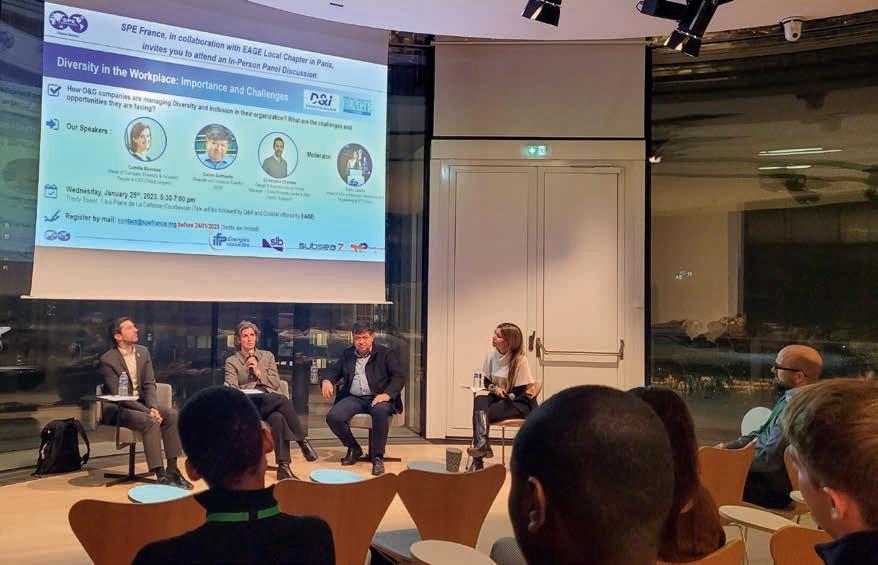
On hand to talk about ‘Diversity in the Workplace: Importance and Challenges’ were three speakers - Camille Manceau (Head of Company Diversity & Inclusion, TotalEnergies), Christophe Chanteur (design and analysis deputy group manager, Subsea 7) and Carlos Sarmiento (diversity and inclusion director, SLB).
One reason for D&I was said to be talent acquisition and retention. Such a workplace can help attract and retain top talent from a wider pool of candidates and can also increase employee satisfaction and engagement. Other important aspects are innovation and creativity. Diverse teams bring a variety of perspectives, experiences and ideas to the table that can lead to more innovative and creative solutions to tackle business challenges. Additionally, a diverse workforce can better understand and serve a diverse customer or client base, leading to increased satisfaction and loyalty. D&I can also help companies’ reputation and
strengthen the brand image. Companies that prioritize D&I are often seen as more socially responsible and ethical which can enhance their reputation and company image. Lastly, in many countries companies are legally required to comply with diversity and inclusion laws and regulations. The speakers concluded that overall, embracing diversity and fostering an inclusive culture can benefit a company while also promoting social justice and equality.
The panellists shared their best practices for building D&I strategies which included conducting a diversity assessment. Manceau suggested prior to creating a D&I strategy, it is important to understand the current state of diversity within your organization. This may involve collecting demographic data, surveying employees and assessing policies and practices for bias. She added that it is required to set clear and measurable goals for the D&I strategy proposed. This will help to track progress and demonstrate the impact of your efforts.
Chanteur said the most important thing is to develop a plan of action. Based on your assessment and goals, create a detailed plan of action with specific initiatives, timelines and
There are five steps to developing a new D&I strategy, according to these experts. The first step is to develop a business case: make a compelling case for how D&I can benefit the organization, for example, increased innovation, improved customer satisfaction and better talent acquisition and retention. Sarmiento highlighted the importance of involving leaders in the development of the D&I strategy from the beginning and soliciting their input and feedback. Chanteur added that facts speak louder than opinions: use data and evidence to support the need for D&I initiatives and demonstrate the impact of previous efforts. A company should provide leaders with training and education on the benefits of D&I and how to promote inclusion in the workplace. Manceau concluded that company commitment should demonstrate D&I at all levels of the organisation, from the CEO to frontline managers and ensure that leaders are held accountable for progress.
If you live or work in the Paris area, make sure to connect with EAGE Local Chapter Paris to get involved in their next activities, or connect with the EAGE’s global network of Women in Geoscience & Engineering via LinkedIn to support D&I.
12 FIRST BREAK I VOLUME 41 I MAY 2023 EAGE NEWS
Animated discussion in Paris.
This year’s high performance computing workshop scheduled for Lugano in September
There are so many good reasons to join us in Lugano on 25-27 September and find out how high-performance-computing has advanced, as well as meeting your peers and experiencing the diverse activities that await you at HPC 2023.
The three-day workshop led by co-chairs Amik St-Cyr (Shell) and Nicola Bienati (ENI) and other technical committee members will feature both oral presentations, panel sessions and keynotes from the leading experts in the industry, as well as plenty of discussion sessions embedded into the programme. The workshop will also provide participants a chance to visit Lugano’s Centro Svizzero di Calcolo Scientifico (CSCS).
Context for the event now being held for the seventh time is the looming worldwide energy crisis which makes clear that for some time to come, energy companies will continue to develop and rely on even more sophisticated HPC architectures and subsurface imaging algorithms to exploit and better develop the energy of the present, that is oil and gas. At the same time, energy transition and decarbonisation are due and unstoppable processes, and all upstreamers must realize there is no longer, as in the past, an infinite time horizon to explore and develop new oil and gas resources.
Geophysical Prospecting (GP) publishes primary research on the science of geophysics as it applies to the exploration, evaluation and extraction of earth resources. Drawing heavily on contributions from researchers in the oil and mineral exploration industries, the journal has a very practical slant. A new edition (Volume 71, Issue 4) will be published in May, featuring eighteen articles.
Editor’s Choice article:
• A logical error in Gassmann poroelasticity –Leon Thomsen
• A generalized source-distance semi-automatic interpretation method for potential field data –Gordon Robert Cooper
Petroleum Geoscience (PG) publishes a balanced mix of articles covering exploration, exploitation, appraisal, development and enhancement of sub-surface hydrocarbon resources and carbon repositories. A new edition (Volume 29, Issue 2) will be published in May, featuring eight articles.
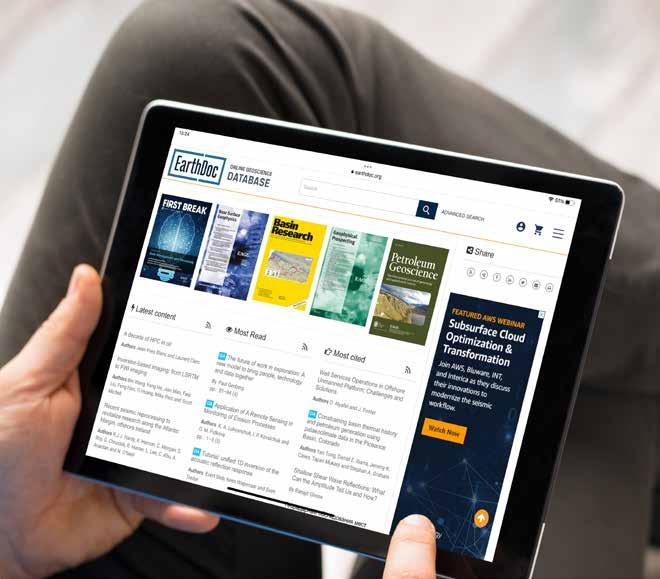
Editor’s Choice article:
• New insights into the stratigraphic evolution of southwest Britain: Implications for Triassic salt and hydrocarbon prospectivity – S. S. Husein et al.
Looking across multiple industries, our business undoubtedly exploits the largest HPC capacity. In this new scenario, HPC and AI will continue to play a key role in the coming years, by accelerating the conventional upstream processes, a clear need in the energy transition process.
The deadline to submit abstracts for the workshop technical programme is 20 May 2023. Visit the event website for more information on topics and guidelines. https://eage.eventsair.com/eage-seventh-high-performancecomputing-workshop/

FIRST BREAK I VOLUME 41 I MAY 2023 13 EAGE NEWS
GP PG
CHECK OUT THE LATEST JOURNALS OUR JOURNALS THIS MONTH
HP computing at work.
Rio venue for conference on deepwater equatorial margin
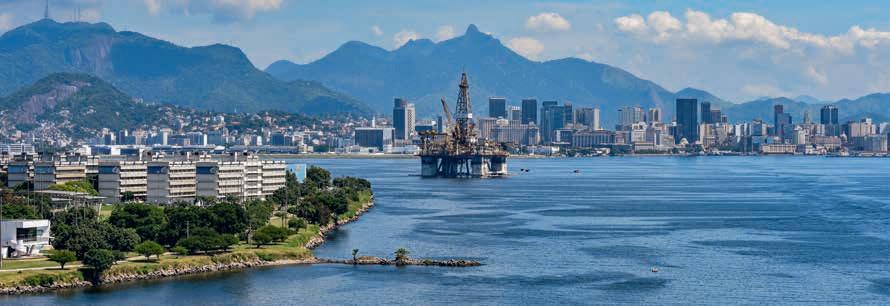
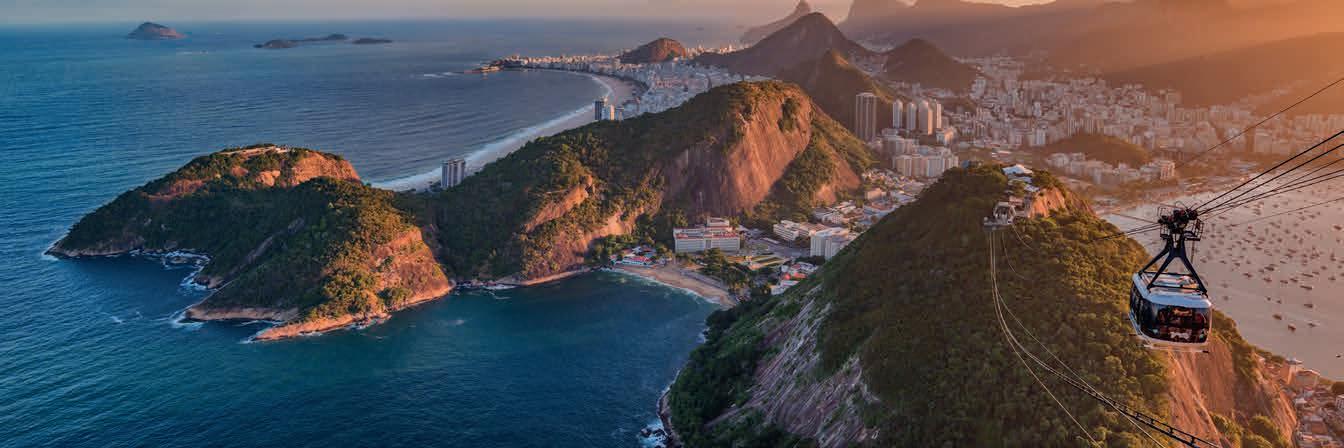
Oil and gas exploration, new technologies, energy transition, environment challenges and carbon capture are some of the topics to be included in the ‘First EAGE Conference on Deepwater Equatorial Margin: New Energy Frontier for South America’ on 16-18 August 2023 in Rio de Janeiro with expected discussion and interaction between professionals and researchers from different areas.
The Brazilian Equatorial Atlantic Margin occupies an area of more than 650,000 km2 across five offshore basins, from Potiguar in the SE to the Foz do Amazonas in the NW. Nowadays, it presents an enormous potential for socio-economic development in the north of Brazil and is a promising exploratory frontier. Furthermore, current global energy demand and its challenges, and proximity to recent success in the Guyana-Suriname basin are the perfect ingredients to attract interest to the Brazil margin.
Held under the main theme ‘From exploration to production with social sustainability’, the event may feature sessions on South Atlantic Equatorial Margins HC plays: targeting the Brazil Equatorial Margin, but also its conjugate in Africa and Guyana Suriname; Digital Transformation and Computational Technologies; Role of the Equatorial Margin in the Energy Transition; Environment, Social, Regulation and Academia; Lessons Learned from Deepwater Drilling Activities, and Development, Engineering and Economic aspects.
At the event participants can look forward to keynote presentations from Neil Piggott (Hess Corporation), Jonilton Pessoa (Petrobras), Francois Baillard (Iraya Energies), Pedro Victor Zalán (ZAG Consulting in Petroleum Exploration), and Ronan Ávila and Raphael Moura (ANP).
You are cordially invited to be part of the conference as it will be an excellent opportunity to network with players directly involved in unlocking the potential for this area.
Read more:
supports student activities that help students bridge the gap between university and professional environments. This is only possible with the support from the EAGE community. If you want to support the next generation of geoscientists and engineers, go to donate.eagestudentfund.org or simply scan the QR code. Many thanks for your donation in advance!
The EAGE
14 FIRST BREAK I VOLUME 41 I MAY 2023 EAGE NEWS
DONATE TODAY!
Student Fund
‘From exploration to production with social sustainability’: join the conversation in Rio de Janeiro, Brazil.
The Brazilian Equatorial Atlantic Margin occupies an area of more than 650,000 km2
Personal Record Interview
Life of a Ukrainian academic refugee
Olena Ivanik is professor and head of department of General and Historical Geology, Institute of Geology at Taras Shevchenko National University of Kyiv; but since the invasion of Ukraine by Russia has been temporarily working at the University of Lorraine, France. She serves on the committee of EAGE Geohazards Technical Community which is the main focus of her research and teaching career.

Geology has been a family affair
Geology is the profession of our family; my parents are well-known geologists in Ukraine. Their entire lives they worked at the Institute of Geological Sciences of the Academy of Sciences of Ukraine, enriching the field of geology with their innovative ideas related to paleontology, stratigraphy, and marine geology (my father participated in numerous scientific expeditions in the world’s oceans). As a child, they took me on field expeditions and got me interested in geological riddles, which I am still trying to solve to this day.
First research
My first scientific research was related to the study of Antarctica and Eastern-Antarctic seas; I have been involved in the implementation of the Antarctic programme in Ukraine under the leadership of the famous geologist, academician Petro Gozhyk. Subsequently, my scientific career shifted to the study of the impact of geohazards on pipeline systems using a wide variety of geological and geophysical methods, as well as deterministic modelling.
Fight for democracy
I have always been among Ukrainians, who strive to live in a free democratic society. Together with teachers and students, we took part in the Orange Revolution of 2004-2005. We spent several cold months on the Maidan Square. Subsequently, revolutionary events (only more tragic) repeated themselves in 2013-
2014. And we won! Ukrainians are a strong and invincible nation. I am sure we will defeat Russian invaders. This is a war between good and evil, between democracy and dictatorship, and we are being supported by the entire democratic world. As a geologist who sees the world through the prism of the nature of tectonic processes, current events are analogues to a major tectonic fault between two different worlds. Ukraine is now fighting for survival in an attempt to preserve European values, and serves as the last democratic outpost between Moscovites and the rest of the civilised world.
How is working in Ukraine?
Geology in Ukraine has always been well-advanced. Ukrainians are known for our innovative ideas, perseverance, and hard work. Currently, we are also working on expanding our relations with colleagues from foreign countries: we conduct joint projects, hold conferences and workshops, and issue joint publications. I personally, collaborate with fellow geologists from France, Austria, Canada, Great Britain, Romania, Germany and other countries. I believe such knowledge sharing provides for an invaluable experience.
What projects you are involved in today?
I am currently working with the PAUSE programme at the University of Lorraine (France) in the laboratory of Geochemical and Petrographic Research (CRPG) as a part of the tectonic research group dealing with the assessment of landslide hazard and its impact on society.
Value of EAGE Geohazards Community
Geohazards Community is a network of members interested in promoting development and application of a multi-disciplinary approach to the natural hazards. Many young scientists see their career growth in the field of geohazards assessment. That is why our community was chosen by young scientists to present career prospects at the Annual EAGE conference.
Coping with living abroad.
Despite enormous help form the French government, university staff, and French people overall, living abroad is quite difficult. Half of my family, my mother and husband, who is currently enlisted with the territorial defence unit, are still in Kyiv, and I am very worried about them. It is quite difficult for us to adapt to a life in another country. We did not leave to seek a ‘better life’, we were quite happy with what we had at home, but were forced out by Russian invaders. However, we manage, because we feel constant support from people in France, as I’m sure Ukrainian people do in other places of refuge. It is amazingly encouraging to know that there are people who are not indifferent to us. We are very grateful. I think that after the victory, the Gratitude Festival can become our Venice Biennale. I thank everyone who shares this difficult time with us and all of Ukraine.
Do you intend to return to Ukraine?
Undoubtfully so!
FIRST BREAK I VOLUME 41 I MAY 2023 15 PERSONAL RECORD INTERVIEW
Olena Ivanik








Make sure you’re in the know EAGE MONTHLY UPDATE IMPORTANT DEADLINES 14-17 NOVEMBER 2023 • PARIS, FRANCE SUBMIT YOUR SUBMIT YOUR ABSTRACT! TOWARDS A SUSTAINABLE ERA OF GEOENERGY 27-30 NOVEMBER 2023 PORTO I PORTUGAL www.petroleumgeostatistics2023.org 3-7 SEPTEMBER 2023 EDINBURGH, UK REGISTER TODAY AND SAVE ON YOUR FEES! EAGENSG.ORG ACCESS TO ALL CONTENT? OPT-IN FOR AN ALL ACCESS PASS! LAST CHANCE TO SAVE ! NOW THRU 15 MAY 2023 5-8 JUNE 2023 | EAGEANNUAL.ORG 7 May 2023 Call for Abstracts 2nd EAGE Workshop on Fluid Flow in Faults and Fracture 20 May 2023 Call for Abstracts Seventh EAGE High Performance Computing Workshop 31 May 2023 Call for Abstracts EAGE Workshop on Unlocking Carbon Capture and Storage Potential INNOVATIVE AND OPTIMISED RESOURCE UTILISATION


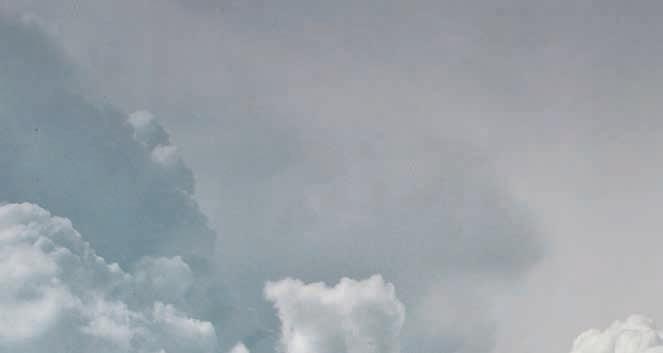


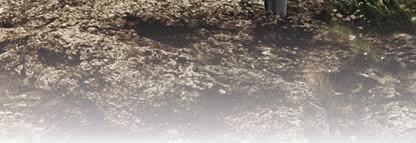



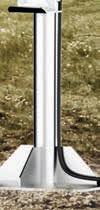
CROSSTALK
BY ANDREW M c BARNET
The lexicon of climate change
A recent official report that the UK is woefully unprepared for climate change received scant attention when it was published in March. Given the list of current ills plaguing post-Brexit Britain, e.g., public sector strikes, food shortages, inflation, a distressed health service, controversial immigration policy, etc, the conclusion of a largely anonymous body such as the Climate Change Committee, however worrying, were never going to make big news or evoke much reaction.
Yet the afore-mentioned Committee, set up back in 2008 by the last Labour government as the Committee on Climate Change before being rebranding in 2020, should have a right to be taken seriously. It is the government’s chief independent adviser on climate change policy filled with suitably qualified members.

Another reason for the underwhelming response may be because it deals with adaptation, the second of three headings in the climate change action lexicon – mitigation, adaptation and resilience, terms that exhibit a confusing degree of overlap in their definition. Mitigation gets all the attention with its focus on reducing carbon emissions. People get this. The big project technologies involved make good copy, e.g., solar and wind turbines, even if sometimes controversial, while your average consumer can relate to electric vehicles and energy saving strategies in their own lives.
More cynically, grand pronouncements on measures to fend off an impending apocalyptic climate future appeal to governments and politicians everywhere: they sound good, even if they often contain more promise than realisation, and as yet in most countries no one is seriously holding them to account.
Adaptation is a less glamorous concept, rather akin to an insurance policy. We resent paying the premium and are only grateful when we have to make a claim. Adaptation quite sensibly asks us to accept that climate change is here for the duration and that we need to start adapting our current living arrangements in anticipation of extreme weather episodes, such as very high temperatures, fires and flooding. Recurring events of this nature have serious
implications for city infrastructures, agriculture, community health and many other vulnerable aspects of society. But as a focus it is a difficult sell, unless a community has suffered some dire event, because it calls for action and spending now to avoid an eventuality that can be put off for now and may never happen. In fact, owing to under-funding, many lauded adaptation programmes around the world often turn out to be small-scale, piecemeal nature-based solutions like restoring salt marshes or protecting peatlands.
The Climate Chance Committee’s findings on UK adaptability status emerge from its biennial report on progress in preparing for climate change as required under the Climate Change Act. They provide an assessment of progress at the end of two National Adaptation Programmes, a statutory requirement to help prepare the country for climate change.
The Committee states: ‘Our assessment has found very limited evidence of the implementation of adaptation at the scale needed to fully prepare for climate risks facing the UK across cities, communities, infrastructure, economy and ecosystems. The impacts from extreme weather in the UK over the last year highlight the urgency of adapting to climate change. The record-breaking temperatures seen in summer 2022 brought unprecedented numbers of heat-related deaths, wildfire incidents and significant infrastructure disruption.’ Baroness Brown, chair of the adaptation sub-comittee that prepared the report, referred to a lost decade of government inaction.
The next National Adaptation Programme (NAP3), must make a step change, according to the Committee, ‘be much more ambitious than its predecessors and lead to a long overdue shift in focus towards the delivery of effective adaptation.’
To be fair, many countries, wealthier ones at least, are further ahead with climate adaptation. But the need for adaptation measures is much more pressing in many, mostly less developed countries. These days there is a Global Centre on Adaptation (GCA), one of a wealth of overlapping international organisations of which most people are probably unaware. GCA is hosted by the
18 FIRST BREAK I VOLUME 41 I MAY 2023
BUSINESS • PEOPLE • TECHNOLOGY
‘Adaptation is less glamorous, rather akin to an insurance policy.’
Netherlands in Rotterdam in the ‘world’s largest floating office’,, proudly designed to be climate resilient and future proof and thus emblematic of the Centre’s intent. ‘From its gently sloping roof layered with solar panels and greenery, to the structure’s base where a heat exchange system generates energy from the river’, the global HQ is said to be completely self-sufficient.
GCA was established in 2018 when the Global Commission on Adaptation was launched in The Hague by UN Secretary General Ban Ki-moon. with the Bill Gates (Bill & Melinda Gates Foundation), and Kristalina Georgieva, managing director, International Monetary Fund, and supported at the time by 23 convening countries. GCA’s mandate, created by the Commission (now disbanded), is to accelerate adaptation worldwide by elevating the political visibility of adaptation and focusing on concrete solutions.
This kind of work is obviously not confined to GCA which in a sense is late into the game and more often than not is a more of a facilitator. Examples abound around the world of projects, typical of the often small-scale adaptation by many different local and international agencies. One random example from the coast of northern Java, Indonesia illustrates what can be achieved. In the Demak district, diverse groups have restored a 20 km belt of coastal mangroves, introduced sustainable aquaculture, and reduced groundwater extraction. The resulting protection from coastal flooding and improved aquaculture productivity have increased resilience for 70,000 people, with additional carbon storage, biodiversity, and fisheries benefits. Many projects, especially on the African continent, are more ambitious.
Ironically, GCA on its website features the UK Thames Barrier, opened in 1982, as ‘an iconic example of building robustness and flexibility in the face of uncertainty. By holding back storm surges and high tides, it helps protect 1.3 million people, £275 billion in property and infrastructure, and places of high historical and cultural value from flooding’. Originally designed to be good until 2030, recent studies show that based on current sea-level rise projections and the ability to raise embankments, it can now protect London until 2070 with the government committed to a review of options for after that time in 2040.
The range of adaption needed globally is overwhelming in magnitude, and initiatives from organisations like the GCA are just a fraction of the highly fragmented efforts underway. Just a selection of adaptation candidates under the heading of ‘Projected Impacts and Risks’ listed in the latest sixth assessment report from the intergovernmental panel on climate change (IPCC) makes for salutary reading, e.g., Ecosystems and biodiversity; Food systems and food security; Water systems and water security; Risks from sea level rise; Health and well-being; Migration and displacement; Human vulnerability; Cities, settlements and infrastructure, etc, etc.
The most forbidding issue of all, for which no adaptation appears adequate, is mass population movement in the face of likely climate catastrophes such as extreme heat, fires, melting ice,
and rises in water levels. So called climate refugees are already on the rise. The UN International Organization for Migration meeting in Chile earlier this year called for more accurate data to forecast likely immigration trends. A much-quoted statistic from the Australian Institute of Economics and Peace, which assesses worldwide ecological threats, predicts that at least 1.2 billion people could be displaced by climate-related events by 2050. That is already a highly alarming figure.
Resilience, the other climate change buzz word, is a more elusive term but is generally used to refer to the goal of governments, industries, business and the like working together to build a sustainable environment sensitive to the needs and conditions of all sections of society implying some thought to so-called climate justice.
A Global Resilience Index Initiative was launched in 2020 on the suggestion of Mark Carney, UN Special Envoy on Climate Action and Finance to the Insurance Development Forum (IDF), a public/private partnership led by the insurance industry and supported by international organisations. GRII describes itself as global public good which can form a basis for mobilising the trillions of investment needed to meet the Paris goals on climate-resilient development. It intends to deliver the next generation of analytics to model the impacts of climate change across systems and supply chains, thereby allowing policy makers, financial markets and exposed communities to understand their climate risks to make, communicate and implement better decisions for a resilient transition.
For an unlikely snapshot of the current geographic distribution of climate resilience, look no further than the exhaustively researched Investment Migration Climate Resilience Index introduced by Henley & Partners, a residence and citizenship by investment consultancy with offices in over 40 countries. According to its website, the company advises ‘high-net-worth and ultra-highnet worth-individuals and families, entrepreneurs, and investors, as well as top-level managers, artists, and celebrities of the fashion, entertainment, and sports worlds’ on, among other things, the optimal cities and countries where people, assets, and infrastructure are likely to be better protected from the now inevitable adverse impacts of climate change.
Only 15 countries make the ‘higher resilience’ grade, all European apart from Japan, Australia, South Korea and the USA, which curiously tops the league. A further 23 of mainly wealthy countries make the ‘medium resilience’ slot. The remaining 142 of the 180 in the index fall into the ‘lower resilience’ slot. These are the countries most at risk from extreme environmental events. Infrastructure will be both weaker and more exposed, and the ability to prepare for and respond to the aftermath of extreme weather events will be lower, so probably not recommendable to clients.
The exposure of such economic disparity raises many issues, including energy ethics, an emerging topic and the subject of a future Crosstalk.
Views expressed in Crosstalk are solely those of the author, who can be contacted at andrew@andrewmcbarnet.com.
FIRST BREAK I VOLUME 41 I MAY 2023 19 CROSSTALK
‘Resilience is a more elusive term.’








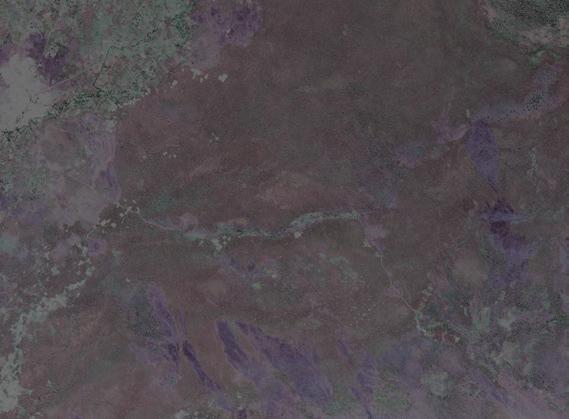



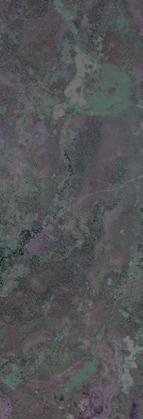
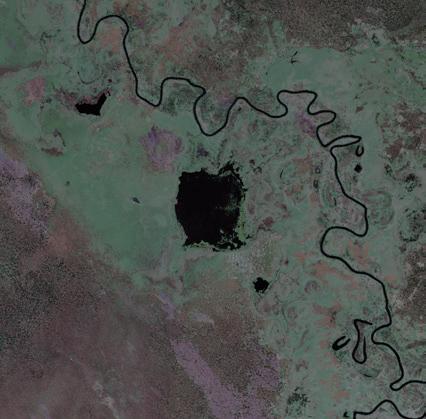
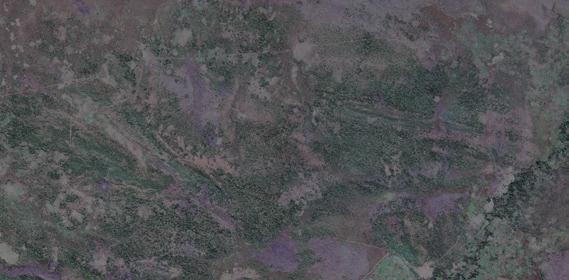
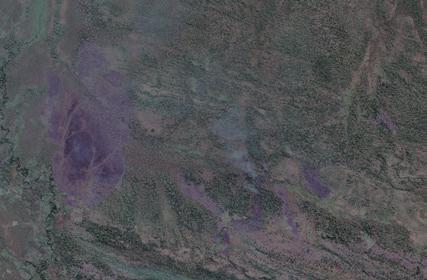



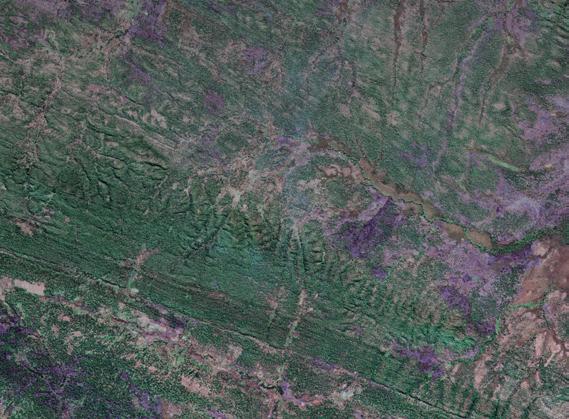

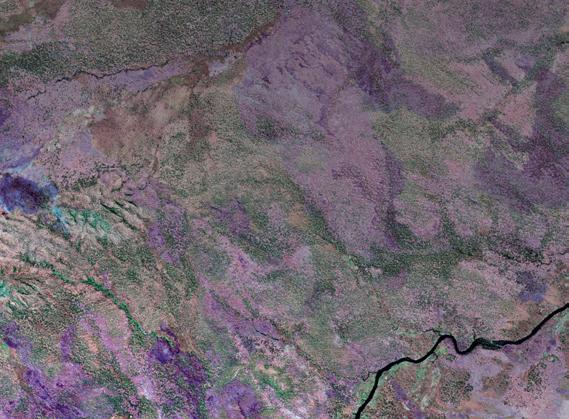
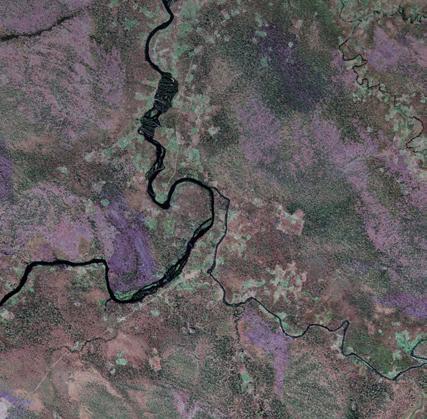
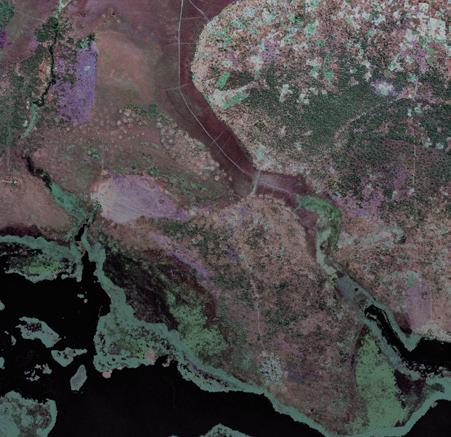




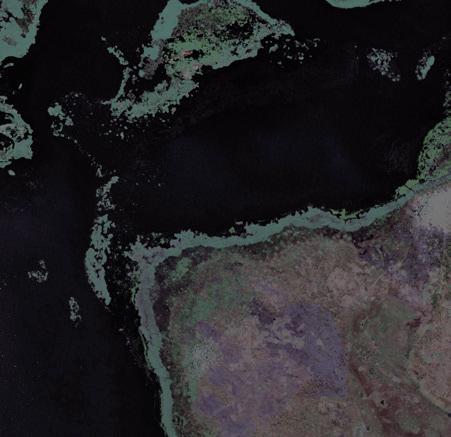


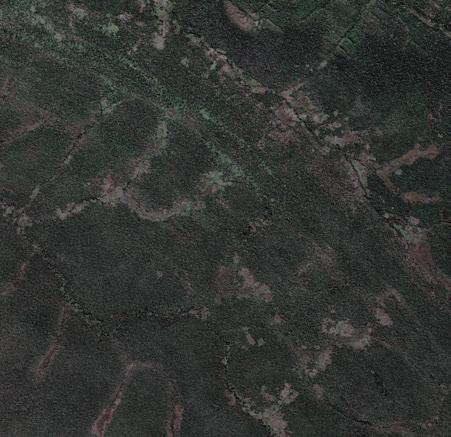




























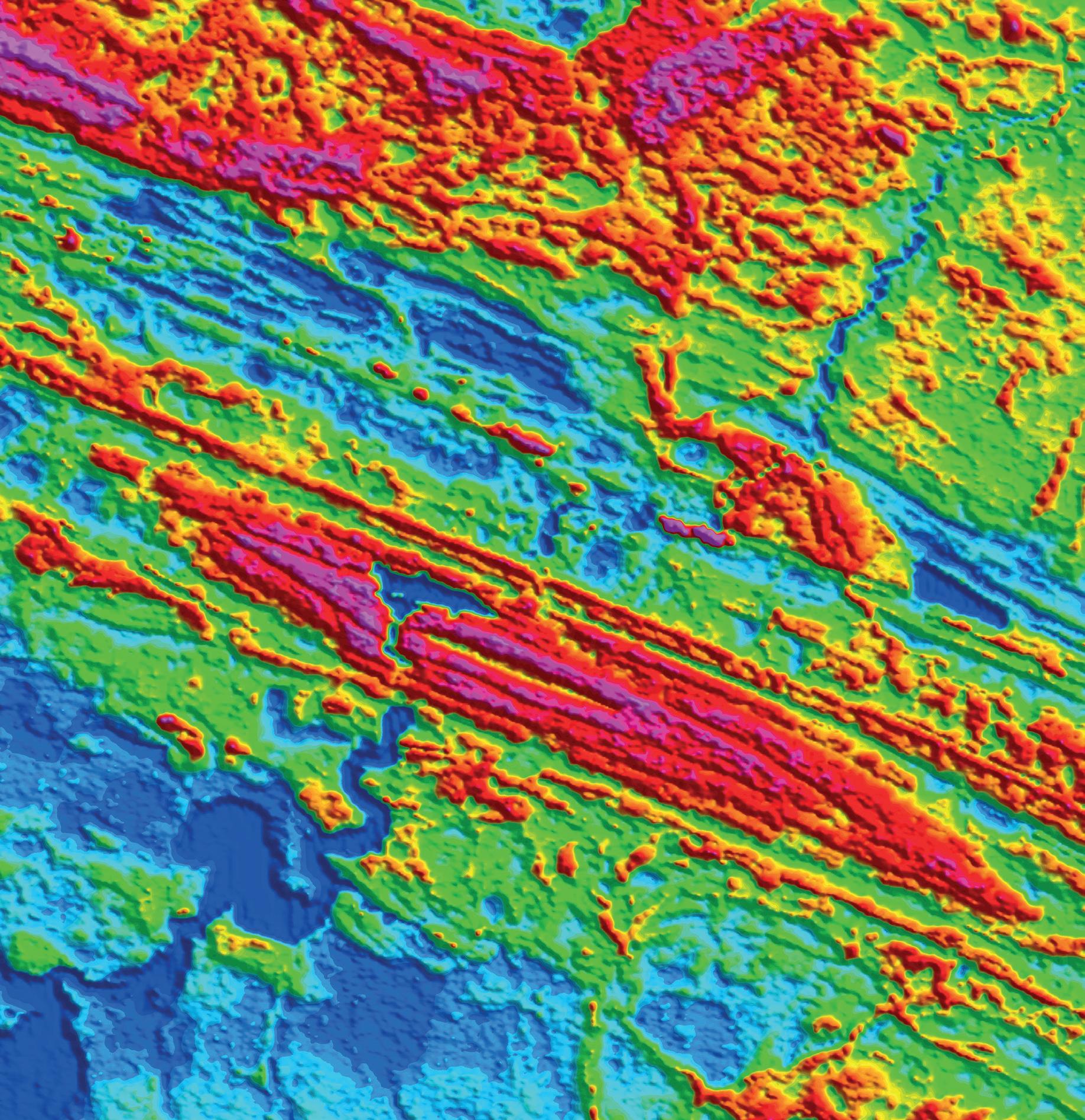
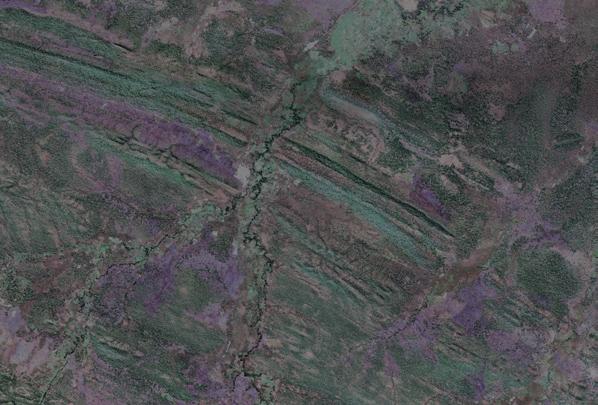








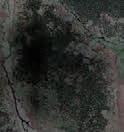








X Astana • X Bogota • X Geneva • X Houston • X Hyderabad • X Kinshasa X Luxembourg • X Madrid • X Ottawa • X Perth • X Pretoria • X Rio de Janeiro • X Toronto Our innovative airborne geophysical technologies allow for efficient exploration reducing environmental impact
TGS extends wind modelling off the US East Coast
Seismic data companies have shown their determination to become bigger players in the offshore windfarm market with TGS extending its wind modelling off the US East Coast and PGS publishing its data strategy for offshore wind projects (see page 22).
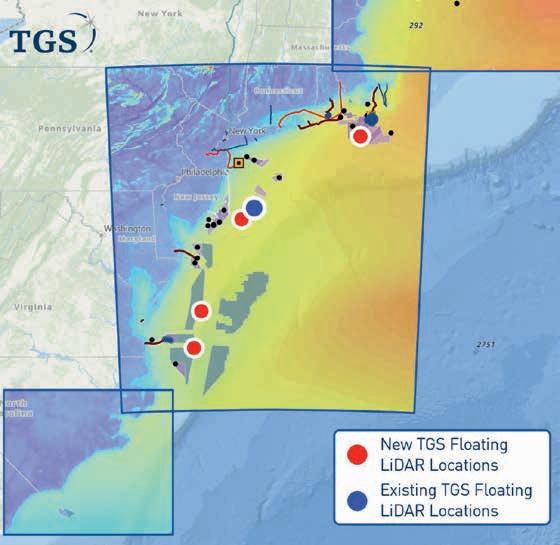
TGS has expanded its multi-client offshore wind and metocean measurement campaign for wind modelling with further deployments off the US East Coast.
In addition to its floating light detection and ranging (LiDAR) buoy in the New York Bight, TGS has deployed a LiDAR buoy offshore Massachusetts, two covering the impending Central Atlantic lease round, and another buoy in the New York Bight area to further enhance its existing data collection and wind modelling of this prime lease area.
In the Central Atlantic, the TGS-deployed floating LiDAR buoys will provide data and insights on a subscription basis to those pursuing wind development opportunities.
Floating LiDAR data will be the only modern and full dataset covering the Central Atlantic lease areas, due to open for bidding in early 2024. Access to such data at this early stage is expected to significantly enhance the decision-making ability of all stakeholders investing in the wind development future of this region, said TGS.
‘In the New York Bight, TGS’ first buoy in the region is performing very

well with high data recovery rates and measuring unique aspects of the wind resource not previously captured by prior modelling studies or measurement campaigns,’ said TGS. ‘Adding a second TGS floating LiDAR buoy will further reduce wind and ocean modelling uncertainties and cycle times for those embarking on site assessment activities. It will further validate TGS’ expansive high-resolution numerical weather prediction (NWP) model data coverage. Similarly, those companies working on wind development offshore Massachusetts can acquire additional data to de-risk final investment decisions or enhance construction and operations plans.’
In all five deployments, TGS is utilising LiDAR systems (with stage 3 validation) from EOLOS. Throughout each buoy’s deployment campaign, data will be acquired continuously with the data stream quality-controlled and made available to customers daily via the Wind AXIOM platform, TGS’ site evaluation and wind data analytics tool. The data package includes metocean and environmental data such as significant wave heights, ocean current profiles and acoustic monitoring of whales, dolphins, birds, and bats.
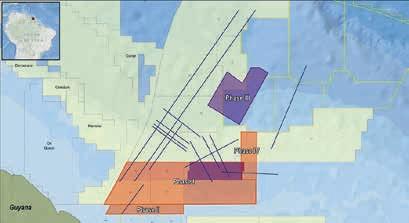
Using aggregated data inputs, including wind models and measurements, Wind AXIOM instantly accesses and processes vast amounts of site-specific data via the cloud. This functionality allows wind developers and stakeholders
to constrain the most influential factors affecting the viability of offshore wind projects and answer questions related to energy output, annual revenue, supply fluctuations, and more.
Jan Schoolmeesters, EVP of Digital Energy Solutions at TGS, said: ‘We identified a need for wind measurements earlier in the development process, but the costs of deploying offshore measurements have been prohibitive and often don’t make sense from a risk-reward perspective. With the multi-client floating LiDAR program, TGS hopes to provide the best data earlier for greater risk reduction throughout the project.’

FIRST BREAK I VOLUME 41 I MAY 2023 21 CGG and TGS
Suriname survey 22 Geotechnical survey for Irish windfarm 26 PGS reprocesses Guyana data 29 HIGHLIGHTS INDUSTRY NEWS
shoot
TGS is deploying five LiDAR buoys for wind modelling off the US East Coast.
CGG, TGS and BGP complete 3D survey offshore Suriname

CGG, TGS and BGP have completed Phase IV of the deepwater 3D seismic survey offshore Suriname. Fast-track products will be ready for review towards the middle of this year, with final products for the entire program available in late 2023.
Covering 1800 km2, Phase IV completes the programmed 14,500 km2 survey of newly acquired 3D data in deep and shallow water in the promising Guyana-Suriname basin. The program also includes more than 6400 km2 of reprocessed data. New multi-client data will support Suriname’s forthcoming deep and shallow water bid rounds.
David Hajovsky, executive vice-president, Western Hemisphere, TGS, said: ‘Suriname continues to play a vital role in expanding the availability of high-quality data in the Southern Atlantic, a priority forTGS.’
Mark Richards, senior vice-president of BGP Multi-Client, said: ‘We believe this project will help to provide clients with a better understanding of this frontier basin, aiding decisions on licensing round opportunities and exploration offshore Suriname.’ The project is backed by industry funding.
PGS publishes seismic data strategy for offshore wind projects
PGS has outlined plans to integrate geological and geotechnical approaches to develop 3D ground models for bespoke design of turbine foundations.
Future offshore wind developments focus on very large turbines with very wide foundations, said PGS chief geoscientist Andrew Long. Installation costs are high. Vertical resolution of geophysical data will make a site-specific approach feasible. However, the traditional approach, where 2D data is interpolated into a 3D model, suffers from spatial uncertainty in soil properties and stability that rapidly
increases with increasing depth below the seafloor, he added.
Techniques commonly applied in the oil and gas industry could reduce installation costs and decrease the risk of failure, such as the wider use of 3D geophysical data collection, and Ultra-High Resolution (UHR) 3D surveys and P-Cable, to provide high-resolution and improved spatial control.
‘Adoption of P-cable techniques could be particularly attractive for improving site life-cycle management because geophysical data can be (re)collected during
windfarm operations, and thereby support decommissioning and repowering plans,’ said Long.
Accuracy of data acquired using towed-streamer seismic methods can improve subsurface insights and feature detection in the near surface, he said. Different strategies combine the merits of both HR and UHR 3D towed-streamer seismic data when building regional ground models in an efficient manner and integrating contemporary views on the role of geosciences throughout the windfarm lifecycle.
UK launches tranche of renewable energy funding

launched and there will be an opportunity for further projects to be added to the first two clusters.
Meanwhile, the UK has also launched a $200 million fund to support the floating offshore wind industry with port infrastructure projects.
held annually, Contracts for Difference will build on UK support for renewable power since 2010 of around $100 billion.
The UK government has announced the next stage of the first carbon capture clusters in industrial areas.
The round for areas to apply for two additional future clusters has also been
It has also launched the $300 million Net Zero Hydrogen Fund to back the first tranche of green hydrogen production projects.
It has opened the fifth round of the UK’s scheme to incentivise investment in renewable electricity, backed by a budget of $250 million. Now being
To boost the nuclear sector it has formed Great British Nuclear to launch a competition to select the best Small Modular Reactor technologies for development by Autumn.
It has promised to speed up the planning process for energy infrastructure, including solar power and offshore wind projects and will provide UK Export Finance with an extra $12.4 billion capacity to boost exports.
22 FIRST BREAK I VOLUME 41 I MAY 2023 INDUSTRY NEWS
Map showing location of different phases of the Suriname 3D survey (image courtesy of CGG Earth Data).
Renewable energy installations soar in UK, says EIC report
UK renewable energy installations have surged in the last year in response to Russian sanctions and growing concerns over fossil fuels, says a report from the Energy Industries Council (EIC).
The EIC’s UK Operational Insight Report 2022 shows that offshore wind dominated the UK’s renewables market, with an installed capacity of 3.2GW in 2022. Onshore wind capacity was also installed across seven small-scale wind farms, while a 50MW South Farm Solar PV Project and three small-scale energyfrom-waste projects opened in 2022. Tees Renewable Energy Plant (REP) in the Port of Teesside, one of the world’s largest biomass plants, is expected to open in 2023.
The UK now has 44 operational offshore wind farms with a combined capacity of 14.5GW, with 2679 wind turbines, the report says, adding that there are also more than 550 operational onshore wind farms in the country with a combined capacity of 15.2GW.
According to the report, installed nuclear capacity decreased owing to the
decommissioning of several reactors, and coal-fired units were extended to ensure energy availability during winter. The report also indicated that although the UK government aims to increase nuclear capacity, the industry faces challenges, including high costs, complex regulatory requirements, in addition to concerns over waste management and safety.
The report from the trade group predicted that the UK will be a world leader in the carbon capture market. ‘Provided it can rollout the necessary policies and investment required to establish a resilient supply chain and a sizeable portfolio of operational projects, the UK has the potential to be a world leader in the global CCUS market,’ said Neil Golding, the EIC’s head of market intelligence. ‘This could be a real opportunity for the UK to help other European countries decarbonise, particularly those that don’t have the necessary storage capacity, especially given the country’s well-established oil and gas supply chains and large offshore storage capacity in the North Sea.’
Two consortia win CO2 storage licences in Norwegian Continental Shelf
Norway has awarded two CO2 storage licences in the Norwegian North Sea.
Wintershall Dea and Altera have been awarded the Havstjerne CO2 storage licence in the Norwegian North Sea. The licence is 135 km southwest of Stavanger and will be operated by Wintershall Dea (50%). Estimated annual storage capacity is up to seven million tonnes.
Wintershall Dea and Altera will develop a system for transporting CO2 by ship to the Havstjerne licence. The partnership has already investigated clusters of emitters in the Baltics, the Netherlands,
Portugal, and Spain for sourcing CO2 for storage.
A consortium of Aker BP (60%) and OMV (40%) has also won a licence for CO2 storage in the southern Norwegian North Sea. The Poseidon licence comes with a work programme which includes 3D seismic acquisition and a drill or drop decision by 2025. The licence could provide storage of more than 5 million tonnes of CO2 per year. The intention is to inject CO2 captured from multiple identified industrial emitters in north-west Europe, including from Borealis’ various industrial sites in Europe.

FIRST BREAK I VOLUME 41 I MAY 2023 INDUSTRY NEWS
PGS releases Colombia data
PGS has released first data from its Pacific MegaProject, evaluating prospectivity across Colombia’s Tumaco and San Juan basins.
Vintage data in the target areas have been reprocessed to create a single MegaProject dataset, which provides new insights into potential petroleum system elements, including features that may indicate of potential hydrocarbon-bearing traps.
Post-stack datasets consisting of multiple 2D and 3D surveys have been matched and merged to produce a phase-balanced and uniformly scaled contiguous regional volume.
‘The regional coverage provided by MegaProject data supports the understanding of tectonic and stratigraphic evolution across entire basins. Regional understanding leads to a robust understanding of existing and potential petroleum systems,’ said PGS.
The Colombia MegaProject covers most of the Tumaco and San Juan Basins. This area is characterised by a forearc basin structural style in convergent margins, relating to the subduction of the Nazca Plate beneath the western part of South America. Along the Colombia pacific margin, thick Cenozoic sedimentary sequences have accumulated over blocks of transitional and oceanic-crust basement that accreted between the Late Cretaceous and Early Cenozoic periods. Overlying sedimentary fill is predominantly Tertiary in age.
The potential petroleum system is related to source rocks of the late-Cretaceous and early Tertiary age, migrated to turbidite fan systems associated with the Miocene interval. Trap and seal are provided by Middle-Upper Miocene shales combined with early-Middle Miocene mud.
‘These basins have significant exploration potential, and the new PGS
MegaProject dataset has been produced in response to renewed interest in this area,’ said Sharon Walker, vice-president of Sales NSA at PGS.
PGS has also released 4460 km of rejuvenated 2D GeoStreamer depth data supporting the evaluation of Blocks D1, D2, and D3, offshore Guyana.
Legend Mining processes large 3D seismic survey in western Australia
Legend Mining has processed a 3D seismic survey over a 24 km2 mining area at the Octagonal prospect, part of the Rockford Project, Fraser Range, Western Australia.
HiSeis was engaged by Legend to conduct a 3D seismic survey to define the Octagonal Intrusive Complex (OIC) in relation to the stratigraphic package, to a minimum depth of investigation of 1500 m.
The $1 million survey is buoyed by strong drilling results from seismic targets explored at the Mawson deposit in 2022. Field teams carried out data collection in November 2022 and processing is now done – the task is now to incorporate existing data sets and conduct further interpretation.
Legend said it was ‘optimistic’ that the seismic work, combined with existing geophysics, depicts compelling nickel-copper sulphide targets outside previous drilling, and that it has identified the potential feeder structure of the Octagonal intrusion.
‘The Legend technical team is extremely pleased to see the detail of the Octagonal seismic cube which shows a strong correlation with geophysical models and structural interpretations from previous drill data,’ Legend managing director Mark Wilson said. ‘In addition, the cube gives new information below and outside of existing drilling, all of which will assist in the ranking of holes for the diamond drill programme at Octagdonal scheduled for May 2023.’
The results highlight ‘excellent correlation between the seismic dataset and the existing structural interpretation’, said Legend.
The newly acquired 3D seismic data supports the exploration model that shows the OIC continuing at depth below drilling completed to date. 3D seismic reflectors clearly map the eastern and western sidewall contacts of the OIC, confirmed by diamond drilling, and importantly the basal contact, said Legend.
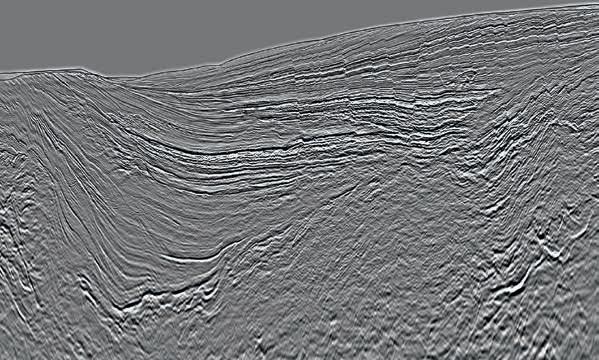
The limited RC and diamond drilling completed to date has intersected multiple intervals of massive, semi-massive, net textured, stringer and disseminated pyrrhotite-pentlandite-chalcopyrite sulphides associated with the mafic/ultramafic intrusives of the OIC.
This mineralisation demonstrates all the characteristics of a fertile magmatic nickel-copper sulphide system, akin to deposits at Nova-Bollinger, Silver Knight, and Mawson in the Albany-Fraser Belt, said Legend. Octagonal sits within the same structural corridor that hosts the Nova-Bollinger and Silver Knight intrusions and nickel-copper-cobalt deposits.
Legend and HiSeis will continue to incorporate existing geophysical, geological, geochemical, and structural datasets. Modelling has identifued multiple new drill targets. The company is organising statutory approvals and the geological team is ranking these new diamond drilling targets for a May start to the 2023 field season at Octagonal.
24 FIRST BREAK I VOLUME 41 I MAY 2023 INDUSTRY NEWS
Rejuvenated data provides new insights into the depositional environment and structural architecture, supporting renewed exploration interest across the offshore Tumaco basin.
Sercel buys structural health monitoring company
Sercel has acquired the assets of Morphosense, a French company specialising in structural health monitoring (SHM) and structural integrity management (SIM) solutions.
‘The additional capabilities and products of Morphosense complement Sercel’s infrastructure monitoring portfolio and open up new market opportunities, such as endto-end SHM solutions for the renewables, nuclear and defence sectors,’ said Sercel.
Created in 2016 and based in Grenoble, Morphosense has developed and commercialised high-end field-proven SHM and SIM technologies, including instrumentation and digital twin solutions, that offer not only early detection of a fault but also identification of the cause
of the failure. ‘This acquisition enables Sercel to offer its customers the most appropriate SHM solution for their needs, both for static and dynamic measurements. With the addition of a digital twin offering Sercel will be able to leverage the high-quality data generated by its own advanced systems to provide better insights to its customers.’
Emmanuelle Dubu, Sercel CEO, said: ‘Sercel is consolidating its position as a significant player in the fast-growing SHM market. This acquisition of Morphosense, together with the recent purchase of our American subsidiary Geocomp, puts Sercel on the path to becoming a global reference in the promising infrastructure monitoring market.’
STRYDE provides seismic solutions to geothermal projects
STRYDE has supplied seismic technology for five geothermal energy projects in the first quarter of 2023, with a further five contracts scheduled to commence during the second quarter of 2023.
It will deploy the company’s technology in the USA, Middle East, and Europe. Two of the ten contracts include nodal equipment supply and seismic data processing for STRYDE’s largest geothermal project to date in the Middle East, as well as a European survey that was conducted alongside a geological research centre in Belgium. Five of the seismic surveys have already commenced, and all ten surveys are expected to be completed by the summer of 2023.
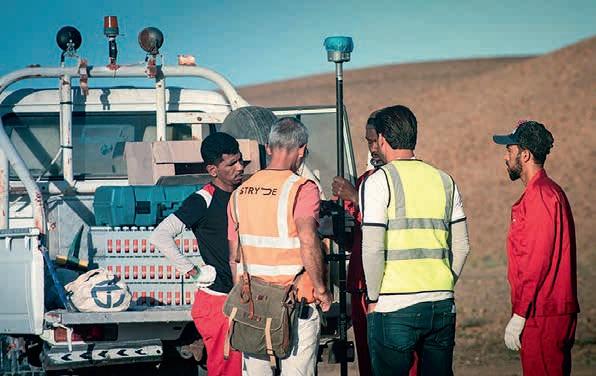
Explore
West Africa
We offer various data types, including 2D seismic, Multibeam, and Seafloor Sampling (MB&SS) studies, providing cost-effective insight across offshore Nigeria, West Africa's most prolific hydrocarbon province.
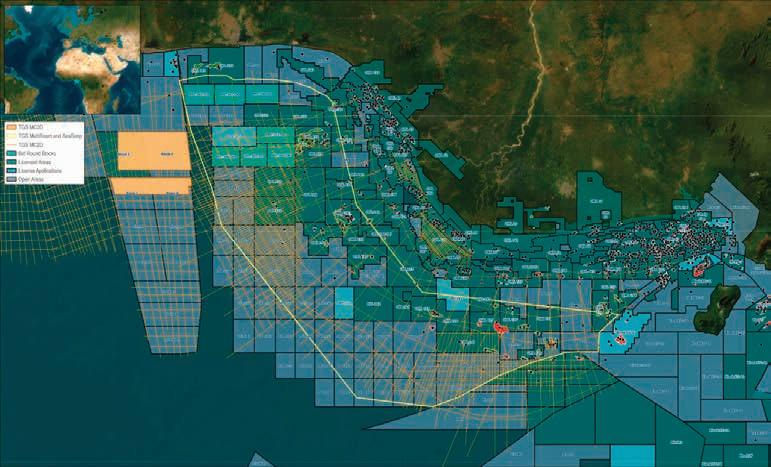
Request a data viewing




‘Until recently, seismic data was seen as an exclusive product of the oil and gas industry, due to the significant Cap and Opex costs associated with acquiring the data. However, with the introduction of miniature, low-cost seismic imaging technology, STRYDE enables high-density seismic data acquisition to be affordable for emerging industries such as geothermal and CCUS to accelerate growth in these renewables sectors,’ said the company in a statement.

The project wins follow the completion of several geothermal projects in 2022, including the first 3D seismic survey specifically acquired for geothermal energy in the UK, conducted by the University of Newcastle at Royal Air Force (RAF) Leeming.
The surveys are enabled by Stryde’s seismic nodal sensor, which it claims is the smallest, lightest and most affordable seismic receiver technology on the market.
‘The company’s technology has proven critical in reducing the size of field crews and accelerating the acquisition of seismic data’ said STRYDE. ‘These efficiencies are even more crucial within geothermal projects in urban environments, with smaller budgets and strict permitting requirements.’
FIRST BREAK I VOLUME 41 I MAY 2023 25 INDUSTRY NEWS
TGS May23.indd 1 05/04/2023 08:07
Field setup of STRYDE seismic data acquisition equipment (source: STRYDE).
PGS raises a $450 million bond
PGS has successfully placed a $450 million senior secured bond, with proceeds, together with available cash, to repay $600 million of the company’s Term Loan B maturing in March 2024.
‘The offshore seismic market is in strong recovery as multiple years of underinvestment in oil and gas exploration and development, combined with a materially changed energy security situation, drive a strong increase of E&P spending,’ said the company in a statement. ‘The transaction materially improves the company’s debt
maturity profile while still allowing PGS flexibility to pursue its deleveraging strategy without incurring excessive costs.’
After the transaction, $138 million of the TLB maturing in March 2024 will remain outstanding and be repaid at par value from cash flow and liquidity sources
The $50 million super senior loan maturing in March 2024 remains in place. The loan may be extended by one year at the company’s discretion or alternatively be replaced by a revolving credit and guarantee facility of up to $75 million.
SSE Renewables plans geotechnical survey for Irish wind farm
SSE Renewables is seeking a licence to carry out survey work on the seabed for a possible 1GW offshore wind farm in the Atlantic Ocean off the coast of Tarbert, Co. Kerry.
Geophysical, geotechnical and environmental surveys are required to inform the renewable energy developer’s understanding of the prevailing environmental and met-ocean conditions at the foreshore investigative array area, 13 km offshore.
The company is developing an ambitious Irish offshore pipeline of up to 4GW, which includes the country’s most advanced offshore project Arklow Bank Wind Park 2 off the coast of Wicklow, and the Celtic Sea Array and Setanta Wind Park projects which are located off Ireland’s south and north-east coasts.
Martin Sweeney, SSE Renewables lead project manager for Blue Seas Development (Ireland), said: ‘This will be our
In early February PGS repaid $83 million on its export credit financing (ECF) loans. The remaining balance of the ECF loans is $180 million.
The bonds will carry a fixed interest of 13.5%. Total interest costs for the company will be reduced after the transaction as the company will have significantly less debt. In addition, the interest on the remaining portion of the TLB is expected to be reduced by 1% as a result of improved credit ratings and lower leverage.
first project in the Atlantic Ocean and our experience in developing our Ossian project in the North Sea off Scotland, one of the world’s largest floating offshore wind developments, will be invaluable.’
Norway launches competition for offshore wind projects
Norway has announced its first competitions for offshore wind areas, to achieve its ambition of generating 30,000 MW in offshore wind by 2040.
The Ministry of Petroleum and Energy has launched a competition for two areas on the Norwegian Continental Shelf, Sørlige Nordsjø II and Utsira Nord in the Norwegian North Sea, with the aim of making awards later this year.
The application deadline for Sørlige Nordsjø II is 4 August 2023 and for Utsira Nord 1 September 2023. Phase one will be awarded after pre-qualification, followed by an auction. There is a minimum of six and a maximum of eight applicants who may participate in the auction, using the British model with open bidding.
The Ministry of Petroleum and Energy will enter into a two-sided contract for Sørlige Nordsjø II phase one. State funding will be limited by an upper ceiling.
Utsira Nord will be awarded by the end of 2023 to three bidders on the basis of qualitative criteria, including innovation and technology development in floating offshore wind.
Utsira Nord is expected to have a capacity of 1500 MW. Three projects will be allocated. The ministry could expand capacity based on NVE’s work in the past year on identifying new areas. An increase of capacity up to 750 MW will be considered for each project.
After the areas have been allocated, developers will conduct an impact
assessment and mature the areas further, before a competition for state funding is carried out. The government will propose a cost framework.
In the proposal, the government will propose that one project does not obtain state funding. Schemes will receive state support for 500 MW each, but will be given the option to build 750 MW. The project that does not receive state funding will retain the right to the area for a period, and may use the general public support system and will be able to participate in possible future competitions, such as state funding for offshore wind.
Norway plans to announce more offshore wind areas in 2025.
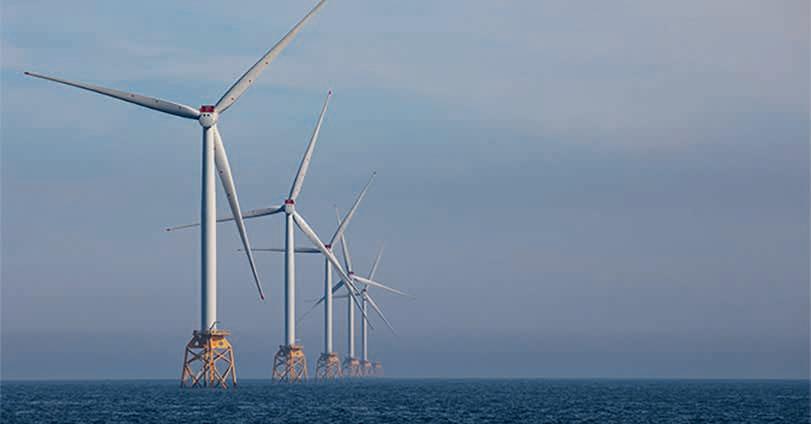
26 FIRST BREAK I VOLUME 41 I MAY 2023 INDUSTRY NEWS
Shell cuts carbon emissions by 30% in six years
Shell’s Energy Transition Progress Report 2022 shows a 30% reduction in carbon emissions compared with 2016 on a net basis.
By the end of 2022, the net carbon intensity of the energy products sold by Shell had also fallen by 3.8%, compared with 2016. Analysis, using data from the International Energy Agency, shows the net carbon intensity of the global energy system fell by around 2% over that time.
The report highlights steps Shell has taken to advance its energy transition strategy. These include significant investments in liquefied natural gas (LNG), which Shell expects to remain an important part of the energy mix for many years to come, partly because of its role in reducing emissions from power generation and transport.
Other steps include Shell’s $1.6 billion investment in Indian renewable power developer Sprng Energy, and the final investment decision on the Holland
Hydrogen 1 project in the Netherlands, which will be Europe’s largest renewable hydrogen plant. In early 2023, Shell completed the acquisition of Denmark’s Nature Energy, which produces renewable natural gas, for around $2 billion.
‘This progress comes at a time when the energy system still faces challenges as high energy prices continue to contribute to a cost-of-living crisis for many people,’ said Shell. ‘These challenges have highlighted the need for a balanced energy transition: one in which the world achieves net-zero emissions, while still providing a secure and affordable supply of energy.
Shell’s energy transition strategy was put to an advisory shareholder vote in 2021, where it secured 89% of the vote. At the 2022 AGM, almost 80% of shareholders who voted supported our progress in implementing this strategy. This year, Shell is again asking shareholders to vote on its annual progress.
IEC prepares 3D seismic survey in Indonesia
Indonesia Energy Corp is preparing a 30 km2 3D survey of the Kruh Block in Indonesia after several encouraging oil discoveries in 2021 and 2022.
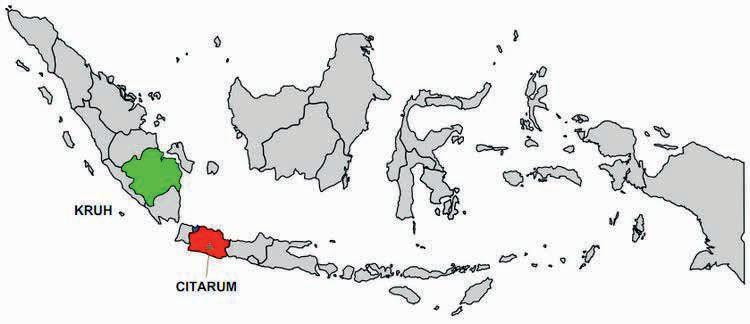
‘The seismic acquisition contractor has been selected and IEC is finalising the detailed plan and model for the exploratory activity,’ said IEC.
The survey will help IEC to ascertain the best locations to conduct its continuous drilling campaign at Kruh Block that will look to develop not only the one formation currently being targeted, but also look to develop what appears to be at least three additional oil formations that could contain significant commercial quantities of oil and natural gas.
After completion and full interpretation of the survey IEC plans to re-start its continuous drilling campaign at Kruh Block. IEC currently expects this seismic survey and interpretation to be concluded before the end of 2023. It plans to drill 18 wells at Kruh Block, four of which have already been completed, by the end of 2026.
At the same time, on IEC’s million-acre Citarum Block, the environmental permit for a 2D seismic survey is in the final approval process. IEC expects to receive the permit in the third quarter of 2023, which would allow IEC begin the data acquisition work in the fourth quarter of 2023.
Frank Ingriselli, IEC’s President, said: ‘We have commenced on our program of conducting seismic operations across the entire Kruh Block so that we can positively leverage what we have learnt from our recent discoveries, including our gas discovery, and look to determine the best locations to start our continuous drilling campaign.’
BRIEFS
Shearwater GeoServices has been awarded a 3D streamer survey by Korea National Oil Corporation (KNOC) off the coast of South Korea. The 1200km2 survey marks its third project for the South Korean national oil and gas company.
PXGEO has secured a contract with the Sépia Consortium for a 3D ocean bottom node (OBN) survey in the Santos Basin, Brazil. The survey will be acquired in water depths to 2300 m with a duration of approx. 4 months. PXGEO executive chairman Peter Zickerman said: ‘This will be our fourth project acquired for Petrobras, since mid-2021.’
The US Bureau of Ocean Energy Management’s (BOEM) Gulf of Mexico Lease Sale 259 has generated $263,801,783 in high bids for 313 tracts covering 1.6 million acres in federal waters of the Gulf of Mexico. Thirty two companies participated in the lease sale, submitting $309,798,397 in total bids. Lease Sale 259 offered approx. 13,600 unleased blocks in 73 million acres in the gulf’s Western, Central and Eastern planning areas. boem.gov/oil-gas-energy/leasing/ lease-sale-259.
Oman has launched its latest bid round, which will be offered in two batches: the first batch consists of Blocks 15, 54 and 36 (onshore blocks) while the second batch (offshore blocks) will be announced by the end of Q2, 2023. The onshore blocks are situated in prospective areas with a mixture of tested producing wells, discovered areas as well as prospects and leads. The Onshore Round will close on 25 June, 2023. ldr. omanbidround.com
Shell has completed the sale of its stake in two offshore production sharing contracts in the Baram Delta, Malaysia to Petroleum Sarawak Exploration & Production. It has sold its 40% stake in the Amended 2011 Baram Delta EOR Production Sharing Contract and 50% in the SK 307 Production Sharing Contract. The sale is in line with Shell’s focus on its upstream portfolio.
FIRST BREAK I VOLUME 41 I MAY 2023 27 INDUSTRY NEWS
ENERGY TRANSITION BRIEFS
Eni will be among the first operators for carbon capture and storage (CCS) projects in the UK after the country announced carbon capture projects that will access the £20 billion in funding. Five projects submitted as part of the HyNet North West cluster (out of seven) have been confirmed in the eight projects earmarked for funding, for which Eni will be responsible for the transportation and storage of CO2 emissions. The other three selected projects (out of 14 submitted) belong to the East Coast Cluster on the East Coast of the UK.
Ørsted has taken the final investment decision on its 920 MW Greater Changhua 2b and 4 offshore wind farms in Taiwan, which it will complete by the end of 2025. The 920 MW grid capacity of Greater Changhua 2b and 4 was awarded in June 2018 in Taiwan’s first competitive price-based auction.
Statera Energy will develop a big green hydrogen project in Kintore, Aberdeenshire. Kintore Hydrogen is a 3GW electrolyser project which will use surplus Scottish wind power to create green hydrogen to supply the UK’s most carbon-intensive industrial clusters through existing gas transmission pipelines.
Getech has secured a £500,000 grant from the UK Government’s Net Zero Hydrogen Fund to support the development of a green hydrogen production, storage and fuelling facility to decarbonise transport in Inverness. The hub, which is targeting first production in 2025, will be powered by an array of wind and solar PV devices. It will scale from 6MW to 24 MW, with the capacity to generate up to 10 tonnes of green hydrogen per day.
CO2 Capsol has been awarded a frontend engineering design (FEED) study in Sweden for the Bioenergy with Carbon Capture and Storage project (BECCS) which involves CO2 captured from biogenic sources such a plants, trees and soil, and permanently stored.
Investment alliance issues net zero guidance on energy projects
The Net-Zero Asset Owner Alliance has issued guidance for members calling on suppliers of oil and gas to set Scope 1, 2, and 3 greenhouse gas emission reduction targets while aligning their operations, including capital expenditure, with established 1.5°C pathways.
Günther Thallinger, Allianz SE board member and chairman of the UN-convened alliance, said: ‘How energy is provided and consumed must dramatically change. This includes the need to phase out non-renewable sources like oil and gas in many, if not most, of its current uses. This challenge must be tackled while balancing the supply of oil and gas on the one hand, and society’s demand for affordable and reliable energy on the other.’
On private asset investment in new oil and gas infrastructure, investors should align with credible 1.5°C net zero scenarios, said the Alliance. This cannot be achieved if there are new upstream infrastructure investments in new oil and gas fields, it added.
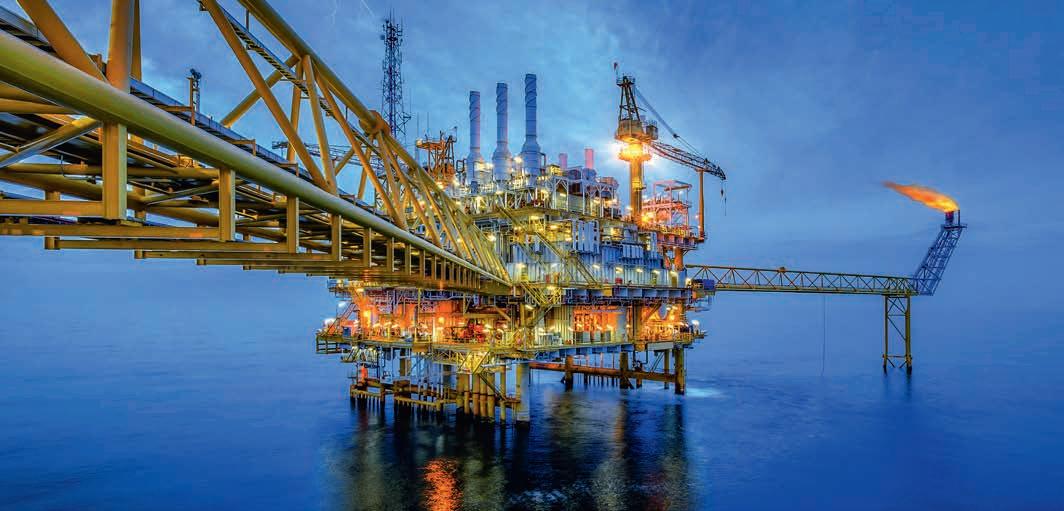
ance strongly advises against investment in long-lived assets that are likely to be stranded in a 1.5°C-aligned transition.
According to the Alliance’s position, oil and gas producers and companies in intensive fossil fuel-using sectors are expected to set science-based, absoluteand intensity-based emissions targets that cover Scope 1, 2, and 3 emissions, in line with science-based 1.5°C-aligned pathways established by IPCC, OECM or IEA NZE 2050 roadmaps.
Policymakers are urged to facilitate oil and gas demand reductions and increase alternative energy supply through economy-wide actions, such as implementing carbon pricing and funding innovative technologies. These actions can help to incentivise decarbonisation, unlock much-needed innovation, and harness capital markets to net zero.
The Net-Zero Asset Owner Alliance comprises 85 institutional investors, with more than $11 trillion in assets under management, committed to transitioning
The alliance recognises that some net-zero committed investors have already put in place policies to cease financing of oil and gas infrastructure. Others may choose to continue to invest in new oil and gas infrastructure in exceptional circumstances, where alternatives for affordable and reliable alternatives are not yet viable or where government-issued regional/ national 1.5°C pathways may influence portfolio decisions. In all cases, the alli-
their investment portfolios to net-zero greenhouse gas emissions by 2050. Alliance members were the first in the financial industry to set intermediate targets (aligned with the Paris Agreement schedule) and they report on their progress annually. The alliance is convened by the United Nations Environment Programme Finance Initiative (UNEP FI) and Principles for Responsible Investment (PRI) and is supported by WWF and Global Optimism.
28 FIRST BREAK I VOLUME 41 I MAY 2023 INDUSTRY NEWS
Alliance members are advised against oil and gas upstream infrastructure investments.
PGS reprocesses offshore Guyana data

‘In addition to providing accurate structural imaging, care has been taken to preserve amplitude fidelity,’ the company added. ‘The data can, therefore, be used both for regional screening and detailed prospect evaluation using amplitude analysis techniques, including inversion for rock properties.


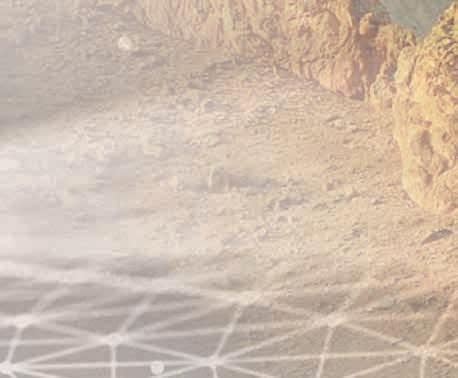
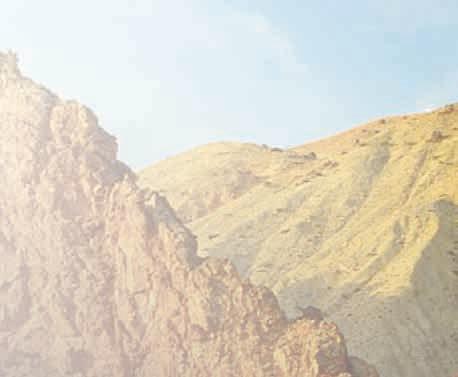
‘Our 2D program is the only available multi-client data over the deepwater blocks and gives companies the ability to assess the area ahead of the licensing round,’ said Elaine Mattos, senior vice-president sales & services at PGS.
Surface and Borehole




Seismic Solutions for Oil & Gas, CCS and Geothermal






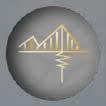




TomoPlus

Imaging & statics for complex near-surface problems




GeoThrust
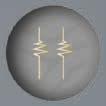
PGS has produced a depth dataset, rejuvenating 2D GeoStreamer data acquired and processed to time-domain (PSTM) in 2009.
Quantitative interpretation products have also been generated to aid the identification of amplitude anomalies that indicate potential hydrocarbon presence.
‘The new PSDM dataset presents an excellent opportunity for E&P companies interested in Guyana’s first deepwater licensing round to evaluate the potential of this highly prospective area,’ said PGS. ‘State-of-the-art imaging technology has been applied to the underlying broadband GeoStreamer acquisition data, providing new insights into the offered acreage.
In Guyana, more than 25 significant hydrocarbon discoveries have been made since 2015, targeting stratigraphically trapped basin floor fans. Exploration activity has provided regional insights regarding maturation, migration, and charge complexities. Similar trends to the prolific ‘Golden Lane’ of discoveries, which include Liza and Stabroek, have been identified in the outboard licensing blocks D1, D2, and D3.
Meanwhile, PGS has won a 3D exploration acquisition contract from a major international energy company. Ramform Titan is scheduled to mobilise for the survey in late June and acquisition is expected to complete in August 2023.
TGS to shoot 3D seismic survey in West Africa

TGS has secured pre-funding for a 3D seismic survey in West Africa. The project will commence in Q2 2023 and will be the first 3D project to be performed under the recently announced multi-year vessel agreement with COSL.
This project will expand TGS’ 3D seismic data coverage, providing high-quality data in a key emerging basin in one of West Africa’s prolific hydrocarbon provinces. The survey will be conducted with long offsets. It
Time and depth imaging in complex near-surface and subsurface areas

TomoXPro


High resolution crosswell imaging and tomography between wells

MiVu




Induced and passive monitoring for water and gas injection

VECON

Surface and VSP survey design and modeling for reducing uncertainty
GeoVS
will be processed using Pre-stack Time (PSTM) and Pre-Stack Depth (PSDM) workflow with Full Waveform Inversion (FWI), enabling improved imaging of the subsurface for acreage evaluation and supporting licensing rounds within the region.
The survey will be acquired by COSL’s Hai Yang Shi You 721 (HYSY721) vessel, scheduled to mobilise in Q2-2023, with final processed deliverables to be completed by Q32024.
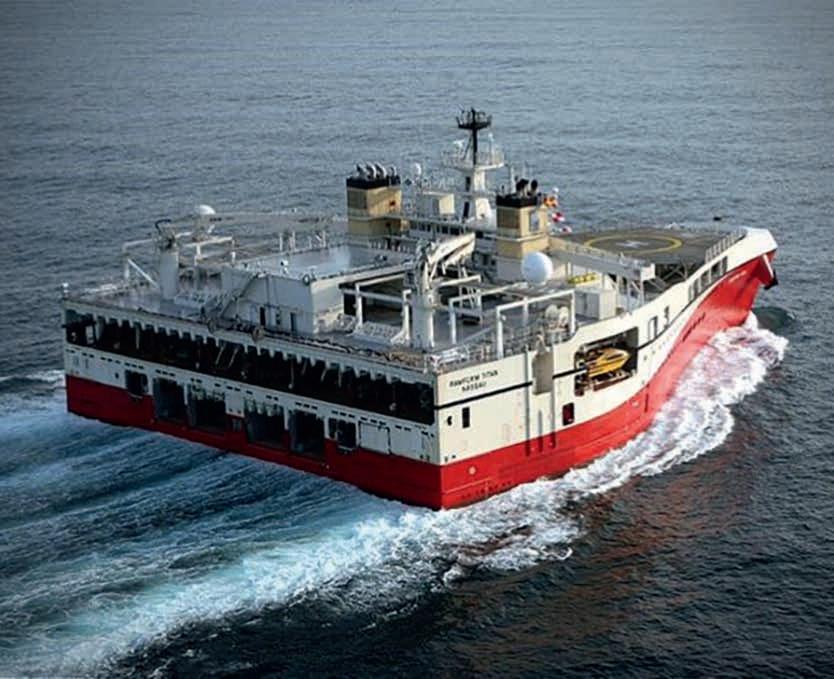






VSP processing and imaging for geophone and DAS arrays


www.geotomo.com


info@geotomo.com

FIRST BREAK I VOLUME 41 I MAY 2023 29 INDUSTRY NEWS
Ramform Titan.
PGS readies fleet for North Sea season
PGS is preparing three vessels for the spring transition to the northern hemisphere.
At its operations base in Florø mid-Norway, Ramform Atlas, Ramform Victory, and Sanco Swift have made pitstops to prepare for three very different seismic acquisition programs.
Ramform Atlas will shoot PGS’ latest GeoStreamer X survey of the Norwegian Sea. Acquisition design will include widetow sources, dense streamers for improved near-offset distribution, and long streamers for accurate velocity model-building. Improved illumination makes it possible to image tricky geological formations in more detail, or to see under obstacles in the subsurface, said PGS. The technique uses PGS proprietary GeoStreamer multi-sensor technology and advanced acquisition solu-
Oil and gas briefs
Shell has made a final investment decision for Dover, a planned subsea tieback to the Shell-operated Appomattox production hub in the US Gulf of Mexico (GoM). Dover is expected to start production in late 2024early 2025 and produce up to 21,000 barrels of oil equivalent per day (boe/d). Originally discovered in 2018, Dover is in Mississippi Canyon, approximately 275 km offshore southeast of New Orleans, Louisiana in about 7500 feet of water. Shell has 100% working interest in Dover. The development concept for Dover is a subsea tieback to the Shell-operated Appomattox production hub. Shell operates Appomattox with a 79% working interest, with CNOOC (21%).
Equinor has again struck oil and gas near the Troll field in the North Sea. This is Equinor’s eighth discovery in the area since 2019. The volumes are estimated at between 24 and 84 million barrels of oil equivalent, with slightly more oil than gas. The Heisenberg discovery well was drilled by the Deepsea Stavanger drilling rig. Equinor is the operator, and DNO is a partner.
Eni has discovered oil on the Yatzil exploration prospect in Block 7, in the middeep water of the Cuenca Salina in the Sureste Basin, offshore Mexico. The discovery is estimated to contain around 200 million barrels of oil (MBoe) in place. It is 65 km
tions. Data acquisition is processed together with underlying broadband library data, to produce a large, dense, multi-sensor, multi-azimuth dataset within a matter of months, and at a highly efficient rate, the company added. PGS first brought its GeoStreamer X multi-azimuth formula to the Norwegian Sea in 2022 and will continue its acquisition there in 2023 and 2024.
Ramform Victory is returning to active duty, repainted and refreshed inside and out. This sister ship to Ramform Vanguard will be heading to Brazil later in the year to focus on a 4D seismic contract for Petrobras. PGS is responding to increasing market demand for 4D seismic acquisition, the company said.
At the outermost dock, Sanco Swift is being rigged with P-Cable technology
for acquiring ultra-high-resolution seismic targets in the shallowest subsurface areas, having entered the PGS portfolio after the company’s acquisition of NCS Subsea. ‘Ultra-high-resolution seismic techniques can satisfy a number of subsurface imaging demands. Sanco Swift’s first project with P-Cable will be a wind farm site survey in Europe,’ said PGS.
‘So far, demand for seismic services is looking buoyant this year, with activity in all geo-markets. Sanco Swift is the first of the three vessels to move from Florø. Ramform Atlas will follow as the weather opens and the work is complete, and Ramform Victory rerigging is on schedule for project start-up,’ said Rob Adams, EVP of operations at PGS.
off the coast, and 25-30 km from discoveries. The well was drilled to a water depth of 284 m and reached a total depth of 2441 m. Yatzil-1 EXP found in excess of 40 m of net pay sands with good quality oil in the Upper Miocene sequences with excellent petrophysical properties confirmed by subsurface data collection. Eni is the operator with 45%, Capricorn (30%) and Citla Energy (25%).
Invictus has raised $10 million to support an exploration campaign in Zimbabwe’s Cabora Bassa Basin. ‘Preparations of our Phase 2 exploration and appraisal campaign are well advanced, with the 2D seismic campaign anticipated to kick off in May,’ said Invictus. ‘This seismic campaign will help to mature multiple identified leads in the proven fairway into drill ready prospects, both along trend from Mukuyu and in the highly prospective Basin Margin play. We also remain on track to spud the Mukuyu-2 appraisal well in the third quarter of 2023, targeting multiple hydrocarbon (gas-condensate and potentially light oil) bearing intervals encountered in the Mukuyu-1/ST1 well in the Upper Angwa, Pebbly Arkose and Post Dande formations.’
Global Petroleum has upgraded prospective resources for its licence PEL0094, offshore Namibia. After analyses of the
existing 3D seismic data in PEL0094, the Unrisked Gross Prospective Resources for the Marula prospect have increased from 218 to 411 million barrels (Mean), an increase of 89%. Together with the Welwitschia Deep prospect and the seven leads so far identified in the licence area, this gives a new total Unrisked Gross Prospective Resources (Mean) of 3522 million barrels of oil for the licence, an overall increase of 6%. The Prospective Resources (Mean) Net Attributable to Global for Marula are now 321 million barrels (previous estimate: 170 million barrels), giving total Unrisked Net Prospective Resources (Mean) on the Licence of 2747 million barrels, also an overall increase of 6%.
Equinor (51%) and DNO (49%) have confirmed an oil and gas discovery on the Heisenberg prospect in the Norwegian North Sea licence PL827S. The discovery well encountered hydrocarbons in Hordaland Group sandstones of Paleogene Age. Preliminary estimates of gross recoverable resources are in the range of 24-84 million barrels of oil equivalent. A part of the discovery may extend into the adjacent PL248F license in which DNO holds a 20 percent interest. Heisenberg may ultimately be tied back to the Equinor-operated Troll field about 40 kms to the southeast.
30 FIRST BREAK I VOLUME 41 I MAY 2023 INDUSTRY NEWS
Special Topic
GLOBAL EXPLORATION HOTSPOTS
Explorers have a good idea of where global exploration hotspots are but excellent multi-disciplinary geoscience strategies are required to identify sweet spots. This month we focus on some emerging strategies. We also look at how picture is evolving as a result of the energy transition, with hotspots emerging for CCUS, offshore wind farms and geothermal projects. War in Ukraine, bringing sanctions on Russian oil and gas, has highlighted a deficit of energy supply and a more urgent need to explore global exploration hotspots, including deepwater oil and gas projects during the energy transition.
Ahmed El-Bassiony et al present the application of the common reflection angle migration (CRAM) to provide a better depth imaging at the lower Cretaceous complex fault system in AbuSennan field.
Carl Fredrik Gyllenhammar explain why a ‘forgotten’ gas discovery in 1969 in the North Sea is interesting in 2023.
Federico Buriola et al demonstrate a significant imaging uplift over the singleazimuth (SAZ) legacy data in terms of improved illumination, structural imaging, resolution and SNR.
William A Heins demonstrates how the Gulf of Mexico has become a hotspot for CCS.
Kyle Reuber makes a comparison of basins, from frontier to mature, to illustrate their exploration status.
Mike Lakin discusses potential hotspots if a more realistic energy transition and new sources of funding can emerge.
Chris Einchcomb looks at several areas companies typically look at when considering land seismic operations and what costs savings with nodal technology can be made in exploration hotspots such as the Middle East and Asia.
Submit an article
First Break Special Topics are covered by a mix of original articles dealing with case studies and the latest technology. Contributions to a Special Topic in First Break can be sent directly to the editorial office (firstbreak@eage.org). Submissions will be considered for publication by the editor.
It is also possible to submit a Technical Article to First Break. Technical Articles are subject to a peer review process and should be submitted via EAGE’s ScholarOne website: http://mc.manuscriptcentral.com/fb
You can find the First Break author guidelines online at www.firstbreak.org/guidelines.
Special Topic overview
January Land Seismic
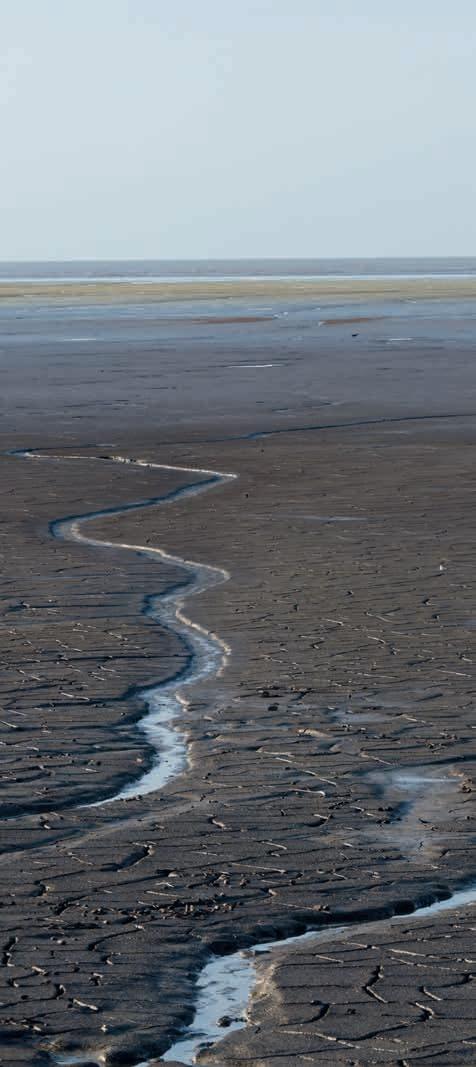
February Digitalization / Machine Learning
March Reservoir Monitoring
April Unconventionals and Passive Seismic
May Global Exploration Hotspots
June Securing a Sustainable Future Together
July Modelling / Interpretation
August Near Surface Geo & Mining
September Reservoir Engineering & Geoscience
October Energy Transition
November Marine Acquisition
December Data Management and Processing
More Special Topics may be added during the course of the year.
50 FIRST BREAK I VOLUME 41 I MAY 2023
































3-7 SEPTEMBER 2023 | EDINBURGH, UK 29th 3rd 2nd 1st Conference on Sub-surface Characterisation for Offshore Wind EAGENSG.ORG u r o p a M e e i n g o f E n v i r o n m e n t a l a n d n g i n e e r i n g G e o p h y s i c s o f r e n ce o n G e o p h y s i c s r f r a s t r u c tu r e P l an n i n g , o n i t o r i n g a n d B I M o n t r u t i n t E x p lo r a t i o n a n d M a n a g e m e n t o f G r o u n d w a t e r L a n d- U s e a n d N a t u r a l H a z a r d s u n d e r a C h a n g i n g C l i m a t e n f e r en ce o n H y d r o g e o p h y s i c s REGISTER TODAY TO BENEFIT FROM THE EARLY BIRD FEE! EXPLORE NEAR SURFACE GEOPHYSICS WITH EAGE THIS SEPTEMBER IN EDINBURGH! MAIN SPONSOR
Winds of Change – Making the transition from the hydrocarbon to the offshore wind industry
Monica Calvert, technical project manager for the transfer of offshore wind farms from EPC (engineering, procurement and construction) to operations at Ørsted, in Denmark, shares her views on the similarities and differences between hydrocarbon and offshore wind industries.
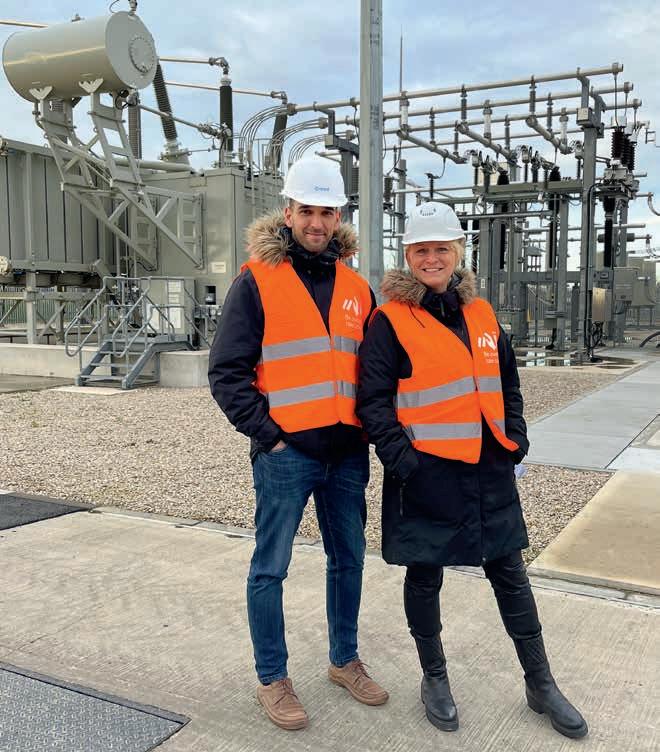
fluids are gathered before being transported via pipeline or vessel to shore to eventually provide customers with energy or derivative products.
When developing an offshore wind farm, a team analyses all the available meteorological data to determine the optimal field development to maximise value. In this case, the focus is on where to place the wind turbines. Each turbine creates a wake causing a loss of energy to the other turbines located in this wake. Hence the windfarm layout needs to be optimised to minimise this loss of energy. Once the turbine layout is defined, including the array cables that connect the turbines, the number and location of offshore substations can be determined. The offshore substations collect the power and prepare it for transmission to shore via export cables, on its way to eventually providing customers with energy. Sound familiar? As my understanding of offshore wind farm development improved, it became clear why many of the people developing the wind farms come from the oil and gas industry.
The energy transition from hydrocarbon to wind has been picking up speed in the past few years. After 28 years as a geophysicist working in the hydrocarbon industry, I made the move in the spring of 2022. What enabled the move wasn’t the years spent refining and expanding my knowledge of geophysics, but rather the technical project management and communication skills that are fundamental when working in diverse technical project teams. After almost a year working in offshore wind, I would like to share some reflections on the similarities and differences between the industries.
Distinct, yet alike industries
One of my first revelations was how similar the development of an offshore wind farm is to that of an oil/gas field. When planning a hydrocarbon field development, a team analyses all the available subsurface data to determine the optimal field development to maximise value, answering questions like how many wells and well placement. The team then designs the offshore production/processing facilities where all the produced
There is a plethora of other areas that both industries have in common; both are filled with engineers and geoscientists from incredibly diverse backgrounds, with many of the offshore wind geoscientists involved in similar work as in the hydrocarbon industry. Understanding the seafloor and near surface geophysics is critical before installing the wind turbine foundations, laying the cables that connect the turbines with the offshore and onshore substations and eventually visiting the site with jack-up vessels during operations to repair or replace the major components. Both industries have a penchant for acronyms, but just when I thought I was familiar with the language, I discovered GIS (Geographic Information System) stands for Gas Insulated Switchgear in wind. Context is key! Another commonality is currently developing as the offshore wind industry ventures into deeper waters requiring different foundation technologies, including floating systems. This is not only reminiscent of the hydrocarbon industry but draws on the same technological advancements that have driven hydrocarbon production from shallow to ultra-deep water.
Shifting away from exploration and reservoir monitoring
A key difference between the industries is the role of subsurface exploration and reservoir monitoring in the hydrocarbon industry. In terms of exploration in offshore wind, simulation models are built from meteorological data to understand
96 FIRST BREAK I VOLUME 41 I MAY 2023 FEATURE: WHATSUP
Figure 1 Monica Calvert with Ørsted colleague, Jakub Stanosz, at one of the company’s onshore substations.
Views expressed in this article are solely those of the author, who can be contacted at gwenola.michaud@cognite.com
wind potential rather than trying to reveal what is hiding in the subsurface. Additionally, understanding the near surface geology is critical for foundation and cable installation during development. Geophysical and geotechnical surveys are fundamental to building the shallow surface models used in this assessment.
The near surface is also important in the hydrocarbon industry for platform and well placement. However, here the prize itself lies deep within the subsurface. The identification and assessment of potential hydrocarbons in the deeper subsurface is a lengthy process involving a combination of geological and geophysical surveys, seismic imaging, drilling exploration wells and analysing rock and fluid samples to build simulation models. Once a field is producing, this type of work can continue far into the future to monitor fluid movement, reservoir compaction and seafloor subsidence which can lead to the identification of further production or injection wells. This aspect of reservoir monitoring for optimising field development is not present in the offshore wind industry; however, repeat surveys are conducted to monitor the seafloor development to ensure the
integrity around the cables and foundations. This is achieved by making 4D difference maps of bathymetric data. Furthermore, different types of monitoring and data analysis take place to optimise or limit power output.These can include knowing when to adjust the turbine blade angle or rotation of the wind turbine itself. Additionally, there is a nascent utilisation of the offshore wind farm cables as a distributed network of sensors to detect seismic activity, making them an ideal resource for seismic monitoring.
Continuing to provide energy
This past year has been spent on a steeper learning curve than I have experienced in many years and has provided me with a new source of internal energy. I’ve witnessed how similar working in these industries can be, particularly when looking at the development planning of the offshore hydrocarbon fields and wind farms. Some workstreams are fundamentally different, as with hydrocarbon exploration and reservoir monitoring, although seafloor monitoring via bathymetric 4D is common to both.
FIRST BREAK I VOLUME 41 I MAY 2023 97 FEATURE: WHATSUP
Email earthdoc@eage.org to start your FREE 2 week trial today! www.earthdoc.org Connect your institution with cutting edge geoscience and engineering content ■ Access over 75,000 papers and articles ■ Event papers from EAGE and partner associations held around the world ■ IP address authenticated access from your smart phone, tablet, laptop or PC EarthDoc21 V1H.indd 1 12/11/2021 20:16 ADVERTISEMENT



































































































































































































































































































































































































































































































































































































































































































































































































































































































































































































































































































































































































































































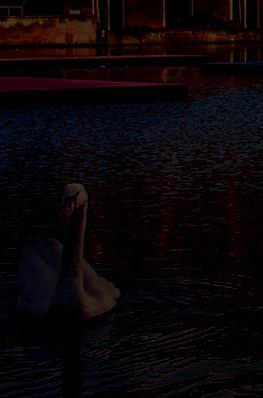





































































































































































































































































































































































































































































































































































































































































































































































































































































































































































































































































































































FOLLOW UP WITH THE LATEST RESEARCH, CONNECT WITH PROFESSIONALS AND DISCOVER THE LATEST ADVANCES 2–4 OCT 2023 THE HAGUE, THE NETHERLANDS INNOVATIVE AND OPTIMISED RESOURCE UTILISATION VISIT WWW.IOR2023.ORG REGISTER TODAY TO SAVE ON YOUR FEES!
CALENDAR OF EVENTS
5-8 JUNE 2023
84th EAGE Annual Conference & Exhibition
Vienna, Austria www.eageannual.org
May 2023
16-18 May Energy Geoscience Conference 2023 www.energygeoscienceconf.org
31 May -
1 Jun
June 2023
DGMK/ÖGEW Spring Conference 2023
Exploring the subsurface potential - make the energy transition happen https://dgmk.de/en/events/dgmk-oegew-early-2023-exploring-the-subsurface-potential-make-energytransition-happen/
5-8 Jun 84th EAGE Annual Conference & Exhibition www.eageannual.org
19-21 June GeoDays 2023 https://geodays2023.b2match.io/

July 2023
9-14 Jul Goldschmidt2023 2023.goldschmidt.info
August 2023
15-16 Aug 2 nd EAGE Workshop on Fluid Flow in Faults and Fracture - Modelling, Uncertainty and Risk www.eage.org
16-18 Aug First EAGE Conference on Deepwater Equatorial Margin: New Energy Frontier for South America
“From exploration to Production with social sustainability” www.eage.org
22-23 Aug EAGE Workshop on Unlocking Carbon Capture and Storage Potential www.eage.org
September 2023
3-7 Sep Near Surface Geoscience Conference & Exhibition 2023 www.eagensg.org
10-15 Sep IMOG 2023 31st International Meeting on Organic Geochemistry www.imogconference.org
Rio de Janeiro Brazil
Kuala Lumpur Malaysia
Edinburgh
Kingdom
98 FIRST BREAK I VOLUME 41 I MAY 2023 CALENDAR EAGE Events Non-EAGE Events
Aberdeen United
Kingdom
Celle Germany
Vienna Austria
Pau France
Lyon France
Canberra Australia
United
Montpellier France
12-13 Sep EAGE Conference on the Future of Energy - Role of Geoscience in the Energy Transition www.eage.org
18-20 Sep Seventh EAGE Borehole Geophysics Workshop www.eage.org
18-20 Sep Second EAGE Seabed Seismic Workshop www.eage.org
20-21 Sep PESGB/HGS Africa Conference 2023 africa.pesgb.org.uk
20-22 Sep First EAGE Conference on Offshore Energy Resources in the South Atlantic www.eage.org
25-27 Sep EAGE Seventh High Performance Computing Workshop www.eage.org
27-29 Sep IPETGAS 2023 www.ipetgas.org
October 2023
Oct Hydrocarbon Prospectivity of the Northern Emirates www.eage.org
2-4 Oct IOR+ 2023 22 nd European Symposium on Innovative and Optimised Resource Utilisation www.ior2023.org
5-6 Oct First EAGE Workshop on Hydrogen & Carbon Capture Sequestration in LATAM www.eage.org
11-13 Oct 7 th World Engineers Convention www.wec2023.com
17-18 Oct EAGE Workshop on Data Science - From Fundamentals to Opportunities www.eage.org
19-20 Oct First EAGE Workshop on Water Footprint www.eage.org
23-26 Oct 15 th Euroconference on Rock Physics and Rock Mechanics euroconf23.dryfta.com
November 2023
Nov Fourth SPE/EAGE Geosteering and Well Placement Workshop www.eage.org
2-3 Nov 2 nd EAGE/Aqua Foundation Indian Near Surface Geophysics Conference & Exhibition www.eage.org
14-17 Nov GET 2023
4th EAGE Global Energy Transition Conference & Exhibition www.eageget.org
15-17 Nov Second EAGE Workshop on Geothermal Energy in Latin America: Worldwide Opportunities www.eage.org
21-22 Nov 2 nd EAGE Workshop on Quantifying Uncertainty in Depth Imaging www.eage.org
21-23 Nov Fifth EAGE Borehole Geology Workshop www.eage.org
27-30 Nov Fifth EAGE Conference on Petroleum Geostatistics www.petroleumgeostatistics2023.org
28-30 Nov EAGE/AAPG Hydrocarbon Seals Workshop www.eage.org
30 Nov1 Dec Third EAGE Workshop on Mineral Exploration in Latin America: “The Role of Mining in the Energy Transition“ www.eage.org
Events
Kuala Lumpur Malaysia
Milan Italy
Milan Italy
London United Kingdom
Montevideo Uruguay
Lugano Switzerland
Ankara Turkey
Ras Al-Khaimah UAE
The Hague The Netherlands
Medellin Colombia
Prague Czech Republic
Kuala Lumpur Malaysia
Bogota Colombia
Woudschoten The Netherlands
Abu Dhabi UAE
New Delhi India
Paris France
Guanacaste Costa Rica
Kuala Lumpur Malaysia
Al Khobar Saudi Arabia
Porto Portugal
Al Khobar Saudi Arabia
Santiago de Chile Chile
FIRST BREAK I VOLUME 41 I MAY 2023 99 CALENDAR EAGE
Non-EAGE Events
















































































































































































































































































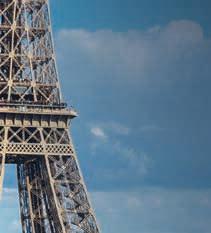







































































































































































































CALL FOR ABSTRACTS DEADLINE 15 AUGUST 2023 14-17 NOVEMBER 2023 • PARIS, FRANCE SAVE THE NEW DATE EAGEGET.ORG HOSTED BY • OFFSHORE RENEWABLE ENERGY • CCUS • ENERGY STORAGE • GEOTHERMAL ENERGY • INTEGRATION • CROSS-USES • ENVIRONMENT & SUSTAINABILITY • SOLUTIONS & SOCIETY • GEORESOURCES IN THE FUTURE • EDUCATION & TRAINING A SUSTAINABLE ENERGY FUTURE ACCELERATING THE PATH TO

























































INCLUDING BUNDLE & SAVE! YOUR OPPORTUNITY TO ENJOY THE FULL EVENT EXPERIENCE AT A REDUCED RATE! JOIN THE LARGEST MULTIDISCIPLINARY GEOSCIENCE & ENGINEERING EVENT REGISTER AT WWW.EAGEANNUAL.ORG DISCOUNT OFFER ENDS ON 15 MAY 2023 HOST SPONSOR MAIN SPONSORS The new All Access Pass includes: -Full Technical Programme -Strategic Programme (New) -Exhibition & Special Theatres -Social & Networking Programme -Workshops, Field Trips, Hackathon and Courses U STAINABLE








































































































































































































































































































































































































































































































































































































































































































































































































































































































































































































































































































































































































































































































































































































































































































































































































































































































































































































































































































































































































































































































































































































































































































































































































































